Clifford Browder's Blog, page 27
July 30, 2017
311. Books That Change the World
Dark Knowledge, my new novel about New York City and the slave trade, is now at the printers; meanwhile, other copies are going out for pre-publication reviews. Once the book is printed, I'll publish excerpts here. Dark Knowledge won't change the world, so let's look at some books that either did, or tried to.
This post is a rambling reflection inspired by the chance convergence of several events:
· On July 4, simultaneous with countless backyard barbecues by others, and Joey “Jaws” Chestnut’s breaking his own record by gobbling 72 hot dogs in ten minutes in Nathan’s Famous Fourth of July International Hot Dog Eating Contest in Coney Island, I exercised my patriotism not by eating hot dogs (I know what's in them, loathe them) but by rereading the Declaration of Independence.· Visiting Paris on July 14, our illustrious president celebrated Bastille Day and so commemorated the French Revolution (the first; there have been so many).· Reading Helen Rappaport’s Caught in the Revolution: Petrograd, Russia, 1917 – A World on the Edge, I experienced the Russian Revolution as seen through the eyes of Westerners then present in the capital.· An article in the New York Times business section of July 14, entitled, “Tough Times for Disciples Of Ayn Rand,” brought that awesome champion of individualism to mind.· Reading in The New York Review of Books of July 13, 2017, an article by Peter Brooks entitled, “Something Grander Than a Novel,” I was reminded of Victor Hugo’s 1862 epic, Les Misérables.· Working on marketing plans for Dark Knowledge, my forthcoming novel about New York City and the slave trade, I was also reminded of Harriet Beecher Stowe’s novel Uncle Tom’s Cabin.
So now I shall try to weave all these strands together into some sort of pondering on my announced subject, “Books That Change the World.”
What first comes to mind, when one thinks of books that change the world, are sacred texts like the Bible and the Koran. I haven’t read the Koran, though I did try recently (one needs guidance through its massive content), but of the Bible I recall above all a short passage from the Old Testament, “Where there is no vision, the people perish” (Proverbs 29:18, King James Version). This assertion I heartily endorse, and suggest that it does much to explain Hillary Clinton’s recent defeat; she had experience and commitment, but not vision, whereas Bernie and the Donald had vision to spare, as did Obama when he first campaigned in 2008. But this thought did not inspire this post, so on to those that did.
Our Declaration of Independence is a document, not a book, but as a statement of a colony’s determination to achieve its independence it has inspired others and in this way has helped change the world.
Our independence was made possible in large part by the intervention of the French, without whom the victory of Yorktown could not have been achieved. Bastille Day celebrates the people’s storming of the Bastille, a prison symbolizing the tyranny of monarchy. No small part in preparing the revolution was Rousseau’s Social Contract (1762), whose stirring first sentence, “Man was born free and everywhere he is in chains” has always resonated in my mind, as it has in the minds of many. And I can sing the Marseillaise, an anthem born of the Revolution, better than the Star-Spangled Banner, whose ups and downs in register defeat my modest vocal ability. Of course a few nasty details about the fall of the Bastille are all but forgotten For instance, there were only seven prisoners, the star detainee, the Marquis de Sade, having been transferred elsewhere ten days before. And the fate of the commandant, who was stabbed repeatedly and his head cut off and paraded about the streets on a pike. History is usually messy.
 The Storming of the Bastille, by Jean-Pierre Houël. If you look close, in the center you can see the unfortunate marquis, not yet headless, being apprehended.
The Storming of the Bastille, by Jean-Pierre Houël. If you look close, in the center you can see the unfortunate marquis, not yet headless, being apprehended.Reading Caught in the Revolution brings vividly alive the first days of the Russian Revolution in February 1917, which began as workers’ strikes and riots for bread in Petrograd, then spread as more and more people joined in, and became unstoppable when the Cossacks and military sided with the revolutionaries. Foreigners were treated well, Americans were respected for their country’s republican government, and the Marseillaise was sung in the streets. But once again things got nasty when, in the absence of any effective government, the police, and those suspected of being police, were brutally assaulted and lynched, their frozen bodies tossed into the likewise frozen river Neva, and other atrocities committed. Messy history again. While hunger and anger sparked the first demonstrations, Lenin would soon arrive to take charge, and one can cite Marx’s Communist Manifesto as another book that meant to change the world. Even if what resulted in Russia was a distortion of Marx, the significance of the book remains.
 Petrograd, July 4, 1917. Demonstrators flee as the Provisional Government's troops open fire with machine guns. Another messy bit of history.
Petrograd, July 4, 1917. Demonstrators flee as the Provisional Government's troops open fire with machine guns. Another messy bit of history.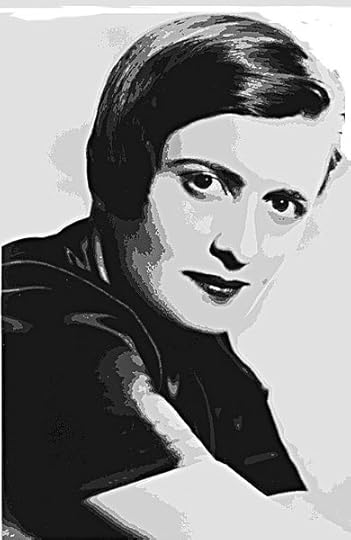 No question, she wanted to change
No question, she wanted to change the world. Now we’ll get to some books that are the antithesis of Marx. The Times article of July 14 observes that our distinguished president, not noted for in-depth reading, calls Ayn Rand his favorite writer, and The Fountainhead his favorite novel. Having plowed through its 694 pages celebrating individual genius and decrying the mediocrity of socialist group think and consensus, I have trouble imagining our Twitterer in Chief, given his known inability to concentrate on one thing for more than ten minutes, achieving the same. But there is no question that Ayn Rand’s books capture the mind-set of the Trump administration. If ever there were books that the author intended to change the world, they are Ayn Rand’s two bestsellers: The Fountainhead and Atlas Shrugged (in my paperback editions, 694 pages and 1,069 pages respectively). And since Rand, born in Soviet Russia, knew the Soviet system only too well and wanted none of it, in this country she advocated the very opposite. But the Times article notes that some of her disciples have been less than brilliantly successful, resigning as CEO of their company or suffering other setbacks, for Rand herself never ran a company or prescribed in detail how an entrepreneur should run a business.
Peter Brooks’s article rejects the frequent claim that Hugo’s Les Misérables is the greatest novel of the nineteenth century, noting how the author never really gets inside the main character, Jean Valjean. True enough, and Hugo’s penchant for grandiose gestures and oratory, which I have experienced in other works of his, do not endear him to the readers of today. I read Quatrevingt-treize (1793), about the royalist rising in Brittany in 1793, in my senior-year French class in high school, and chiefly remember the protagonist, the royalist Marquis de Lantenac, gesturing and orating flamboyantly at every opportunity. But Hugo’s Misérables is nonetheless a prime example of that new phenomenon, the international bestseller, having been translated and read all over the world. It came at the right time, when people were questioning a society – any society – that ignored the needs and suffering of its vast impoverished masses. Whether successful or not as a great novel, it had its impact and went far in attempting to change the world. It’s no coincidence that it inspired a successful musical that premiered in Paris in 1980 and played on Broadway for years.
 From a 1920 French film of Quatrevingt-treize. That character on the left has got to be Lantenac, which says a lot about why Hugo's novels may not fly today.
From a 1920 French film of Quatrevingt-treize. That character on the left has got to be Lantenac, which says a lot about why Hugo's novels may not fly today.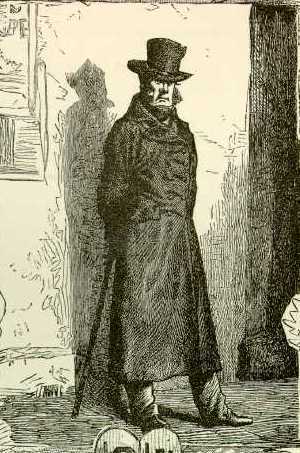 Inspector Javert, from the original
Inspector Javert, from the original edition of Les Misérables (1862).
A man you'd love to hate. I read Les Misérables long ago in, of all places, Anchorage, Alaska, where I spent the summer of my junior year in college working in a kitchen feeding civilian workers on an army base. Desperate for reading, I haunted the public library, meanly housed in a quonset hut while the city basked in the glory of a second downtown street being paved. When I ran through all the library’s minimal offerings in English literature, I clutched at French titles in translation. So I was soon on the barricades with young Marius, and followed Jean Valjean as he carried the wounded young man through the sewers of Paris, the passageway at one point descending perilously into the murky waters before rising again. And of course I came to loathe Inspector Javert, the police officer who pursues Jean Valjean relentlessly over the years. Perhaps in my desperation I relaxed my standards a bit, but Hugo’s epic held me to the end. Whether it would today, be it in French or in English, is another matter.
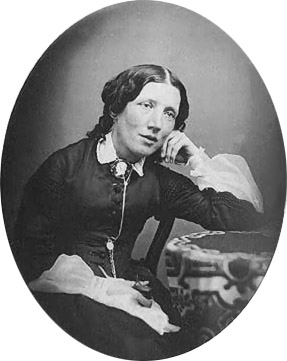 Could she have started that big war? Finally, we come to that other nineteenth-century bestseller, translated into many languages and even inspiring a dramatic rendering, so Broadway would have it, at the royal court of Siam. Like Hugo’s novel, Harriet Beecher Stowe’s Uncle Tom’s Cabin (1852) came at just the right time, when this country, having dodged the issue for decades, was facing at last the problem of slavery and what to do about it. Neither Stowe nor her publisher anticipated its incredible success – 300,000 copies sold in the first year alone. When, at a White House reception during the Civil War, she was presented to President Abraham Lincoln, he said, “So you’re the little woman who wrote the book that started this great war.” A simplification, if true (the story is considered apocryphal), but there is some truth in it. For all its faults and shortcomings – no one would call it a literary masterpiece – it is a book that helped change the world.
Could she have started that big war? Finally, we come to that other nineteenth-century bestseller, translated into many languages and even inspiring a dramatic rendering, so Broadway would have it, at the royal court of Siam. Like Hugo’s novel, Harriet Beecher Stowe’s Uncle Tom’s Cabin (1852) came at just the right time, when this country, having dodged the issue for decades, was facing at last the problem of slavery and what to do about it. Neither Stowe nor her publisher anticipated its incredible success – 300,000 copies sold in the first year alone. When, at a White House reception during the Civil War, she was presented to President Abraham Lincoln, he said, “So you’re the little woman who wrote the book that started this great war.” A simplification, if true (the story is considered apocryphal), but there is some truth in it. For all its faults and shortcomings – no one would call it a literary masterpiece – it is a book that helped change the world. I have tried to read Uncle Tom’s Cabin twice but both times gave it up; it never got hold of me the way a really good novel should. Just reading a synopsis of it, with its many characters and endless turns and twists of plot, wears me out. And the scraps and pieces that everyone knows, or knows of, can be off-putting: Uncle Tom himself, now a symbol of rank subservience; the tear-inducing death of little Eva; and the demonic slaveowner Simon Legree, villain of villains, who has Tom beaten to the point where he departs this earth a Christian martyr. I always imagine Legree as the stereotypical villain of nineteenth-century drama, a towering figure in black, tophatted, who twirls his snakelike mustache with vicious delight. Yet when I once read, as an excerpt, the account of the fugitive slave Eliza clutching her infant as she crossed the ice-filled Ohio River to freedom, I was moved. For us today Stowe’s epic is more a creaky historical document than a piece of literature, but at times the darn thing blazes.
 Eliza crossing the ice with her child. An 1881 theater poster. From reading an excerpt, I remember the ice floes, but not the dogs. So much for my list of books that changed the world, or tried to. What titles would you add? If I’ve left out something obvious, tell me.
Eliza crossing the ice with her child. An 1881 theater poster. From reading an excerpt, I remember the ice floes, but not the dogs. So much for my list of books that changed the world, or tried to. What titles would you add? If I’ve left out something obvious, tell me. BROWDERBOOKS
All books are available online as indicated, or from the author.
1. No Place for Normal: New York / Stories from the Most Exciting City in the World (Mill City Press, 2015). Winner of the Tenth Annual National Indie Excellence Award for Regional Non-Fiction; first place in the Travel category of the 2015-2016 Reader Views Literary Awards; and Honorable Mention in the Culture category of the Eric Hoffer Book Awards for 2016. All about anything and everything New York: alcoholics, abortionists, greenmarkets, Occupy Wall Street, the Gay Pride Parade, my mugging in Central Park, peyote visions, and an artist who made art of a blackened human toe. In her Reader Views review, Sheri Hoyte called it "a delightful treasure chest full of short stories about New York City."
If you love the city (or hate it), this may be the book for you. An award winner, it sold well at BookCon 2017.
Available from Amazon and Barnes & Noble.
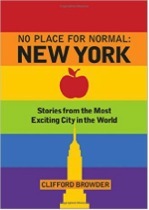
2. Bill Hope: His Story (Anaphora Literary Press, 2017), the second novel in the Metropolis series. New York City, 1870s: From his cell in the gloomy prison known as the Tombs, young Bill Hope spills out in a torrent of words the story of his career as a pickpocket and shoplifter; his brutal treatment at Sing Sing and escape from another prison in a coffin; his forays into brownstones and polite society; and his sojourn among the “loonies” in a madhouse, from which he emerges to face betrayal and death threats, and possible involvement in a murder. Driving him throughout is a fierce desire for better, a persistent and undying hope.
For readers who like historical fiction and a fast-moving story.
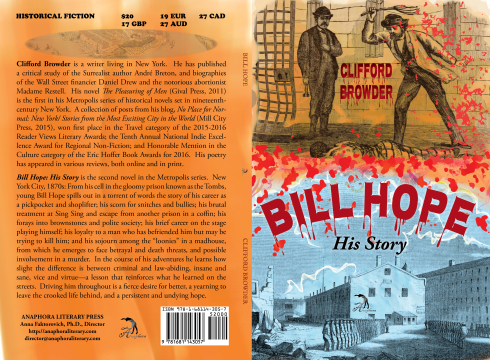
For two new LibraryThing reviews of Bill Hope: His Story, go here.
3. The Pleasuring of Men (Gival Press, 2011), the first novel in the Metropolis series, tells the story of a respectably raised young man who chooses to become a male prostitute in late 1860s New York and falls in love with his most difficult client.
What was the gay scene like in nineteenth-century New York? Gay romance, if you like, but no porn (I don't do porn). Women have read it and reviewed it. (The cover illustration doesn't hurt.)
For Goodreads reviews, go here. Likewise available from Amazon and Barnes & Noble.

Coming soon: WHY I LOVE NEW YORK.
© 2017 Clifford Browder
Published on July 30, 2017 04:08
July 23, 2017
310. 286 West 11th Street: Two fires, a Suicide, a Scream, Washington Crossing the Delaware, Toucans and Macaws
A note on Dark Knowledge (forthcoming from Anaphora Literary Press):
Hundreds of shackled slaves crammed in below, weeping for their lost homeland and kin and pleading for water, till the crew, braving the stench of unwashed bodies, come down to remove the dead and throw them overboard to be devoured by sharks that follow the ship all the way across the Atlantic to its destination in Cuba.
An elegant brownstone parlor with upholstery of silk and brocade, and carved ivory figurines and lacquerware that speak of the China trade, where a hostess in gold-embroidered black satin discusses stocks and bonds and gold with her guests, and the latest novel by Mr. Willkie Collins, the hit play of the moment, and fashions favored by the empress Eugénie of France.
Is there a connection between the two? What could possibly link parlors of silk and brocade to weeping slaves and shark-devoured corpses?
More about this soon. Now on to 286 West 11th.
In New York City every old building has its history, its stories of owners and tenants, and 286 West 11th Street, currently the home of the Magnolia Bakery and Bond no. 9, a luxury perfume shop, at ground level on Bleecker Street, and of myself high atop those enterprises, is no exception. Built in 1905, so the online real estate listings state, it was once a hotel, but in the 1930s it was acquired by the Terrell family, who joined rooms together to create one big and one small apartment on each of the four residential floors, with an entrance on West 11th, while renting out the two ground-floor commercial spaces that face on Bleecker Street.
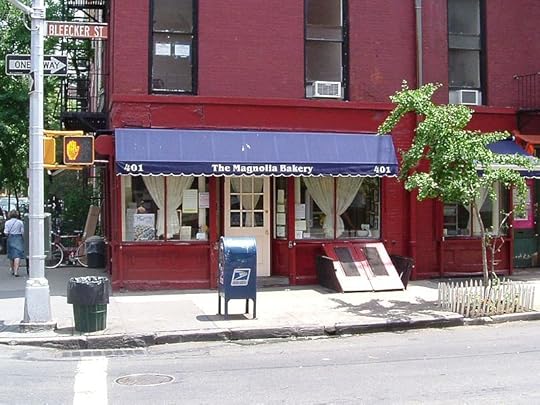 The Magnolia in 2005. The entrance to the apartments is around the corner on
The Magnolia in 2005. The entrance to the apartments is around the corner on West 11th Street, where a bike is parked.
Rob Young My acquaintance with the building dates from June 1, 1970, when my partner Bob and I moved into the top floor back apartment (5B), which the landlady, Rita Terrell, had described to us as the best. It was indeed the best, for the building was one story higher than its neighbors on Bleecker Street, giving us, and no other apartment in the building, a southern exposure as well as a western one, so that the apartment was flooded with light from mid-morning until evening, when a look down West 11th toward the river gave a view of the setting sun. How did we get the place, and at a reasonable rent at that, since it was stabilized? Sheer dumb luck. It was available, and someone had to get it, and by sheer chance that someone turned out to be us. The fact that it was a four-flight walk-up bothered us not at all, except on the day of the move-in, for we were still young and hardy ... at least, hardy enough. Adding to the apartment’s charm were beams that emerged from and then disappeared back into the walls, doors that wouldn’t close, surfaces that were anything but level, and two fireplaces at opposite ends of the apartment, each visible from the other. (Not that the fireplaces were usable; they weren't properly insulated.) We soon installed Salvation Army furniture, which back then came at bargain prices. The star attraction was a chest-on-chest charmingly nicked with age, the drawers with knoblike little lion-faced handles; friends from Washington marveled at it. Viewing the whole apartment’s shabby charm, another friend from the West Cast said, “In California people spend a fortune trying to make their place look like this.”
But this was the 1970s, a time of high crime, as we well knew, since Bob was almost mugged in the vestibule, hurrying with key in hand through the locked second door as someone lunged in through the unlocked outer door. All our windows were secured with locked iron gates, and we soon installed a police lock on the door to the hall as well.
So who were our neighbors? This being New York, they came and went silently, often at times other than when we came and went, so it was a long time before we got to know any of them, and some of them we never did connect with. Our first contact was with our next-door neighbor, Pat, a young woman from England who did costumes for Off Broadway plays, and whose roommate was a chow that on occasion barked up a storm. There was also a family with two young children in one of the big back apartments, but they soon moved out, and that was the last family to reside at 286 West 11th; from then on it was Yuppies.
One floor down from us was Hans, whom we came to know only with the passage of time. His apartment was full of opera recordings – many of them rare – and photos of leading opera singers and conductors, for he worked for an outfit that managed singers, and his world was almost exclusively opera. The first we knew of this was when recordings of great singers drifted up to us, caressing or hammering our ears. Hans had known such stars as Joan Sutherland, Régine Crespin, Birgit Nilsson, Renata Tebaldi, and Luciano Pavarotti, and had stories to tell about all of them – stories that would make a fabulous book with great niche-audience appeal. He has jotted down reminiscences at length and shared them with us online, but I wonder if that book will ever get written. And if he meant it to be published, he would probably hold back all the juicy details known to the people where he worked, but not to be shared with the public.
Our landlady, Mrs. Terrell, had the big high-ceilinged parlor-floor apartment, where she had lived for decades. Elderly now and bedeviled with arthritis, she left the apartment only to sit at the top of the stairs, waiting for the mailman to come. More than once, when I was going out, she gave me her keys and asked me to bring up her mail. She alternated between two contrasting persona: friendly neighbor and professional landlady. As friendly neighbor she was accessible, reasonable, chatty; as professional landlady she turned severe and demanding, warning us about the penalty for not paying rent on time – we who never once missed a payment or paid late. Again in friendly mode, she once phoned me to ask if I had any male friends who might want to rent one of the big apartments. “I’ve seen nothing but dizzy young females,” she said. “I want a responsible male tenant, someone really reliable.” It was a rare opportunity for someone, but none of my friends was looking for an apartment at the time. And by “responsible” and “reliable” she probably meant a young man who could cope with such problems as cracked walls, quirky plumbing, broken sash chains, and all those other mishaps that plague apartments in old buildings.
That Rita Terrell had once been something of an entrepreneur came to my attention one day when I heard a commotion in the hall, looked out, saw smoke swirling up the stairwell, and a fireman knocking on doors. “Do you want us out of the building?” I asked, and for an answer got a resonant “Yes!” Out we went, descending into a smoky haze, aware as we did so of firemen ahead of us carrying Rita down the last flight of stairs. Out on the street the refugees huddled, talking nervously, while the firemen poured water into the basement, where inflammable chemicals had burst into flames. What chemicals? we wondered, and in time got an answer: chemicals from Rita’s former perfume business, stored for years in the basement. Luckily, the fire was quickly contained, and once the building had been aired out, we were allowed back in. Still unsettled, Bob and I and Hans accepted an invitation from our neighbor Pat to have a communal drink in her apartment. “Just like La Bohème, said Hans, ever ready with an operatic reference. “Or Götterdämmerung,” I said, thinking a cosmic holocaust more appropriate.
A total contrast with Hans was Sam, a young Jewish guy who, after Pat moved out, rented the small apartment next to ours. When not making love to his frequent female guests, his voice resonated; I once heard him, just back from a trip, on the phone: “Hiya, Mom! How the fuck are you?” Which gives you the flavor of Sam. Every Saturday evening we heard loud jazzy music with a wild drumbeat blasting through the wall from his apartment, but we knew it would last only a half hour at most: he was revving up for his big night out. Once, though, he and a male friend did assault us a bit more than usual with deafening blasts of jazz. Our solution: play some grand opera and turn it up to a roar. Immediately, groans from Sam’s apartment, since nothing can match grand opera played full blast. We and Sam got along fine, though there were a few memorable moments. He got a kitchen job in a Village night spot that brought him home in the wee hours, often with a lady friend in tow. One night we heard a piercing female scream from his apartment, followed by total silence. Our assumption: Sam’s lovemaking had tried some novel maneuver that took the girl by surprise. On another occasion, when I opened our hall door to put out some trash in the morning, I saw a young blonde, scantily clad, sleeping on the floor in the hall – the result, I assumed, of a lovers’ midnight quarrel. Minutes later, when the super came to collect the trash, I heard a long pause as he lingered on our landing, gazing his fill, before taking the trash down to the curb for collection. When I next looked into the hall, it was empty; reconciliation had been achieved. The following winter, when Sam moved out, giving us a hearty farewell, it was in the midst of a blizzard. Somehow, given Sam’s joyously raucous behavior, this seemed just the right weather for his leaving.
When time and mortality finally claimed Rita Terrell and left her high-ceilinged parlor-floor apartment vacant, a friend of ours named Joe happened to be the one who moved in. He overlapped with Sam and told us of hearing Sam and a girlfriend talking as they went out of the building. “You mean you’re the onlyone?” she asked, dumbfounded. “Yes,” said Sam, “I’m the only one.” Joe knew immediately what they were talking about, and so did Bob and I, when Joe told us about it with a grin. Purely by chance, the mix of tenants had gradually undergone a sea change, and Sam was now the only straight guy in the building.
This gay phase lasted quite a while and coincided with the AIDS epidemic, which affected Bob and me not at all, since we were a closed circle, but targeted some of our younger friends. We suspected that several of our neighbors were at least HIV positive, if not victims of full-blown AIDS. Hugo, a young black man in the third-floor back apartment, had evidently lost his job and now, deep in the throes of depression, sat alone in his apartment morning, noon, and night, eyes glued to his television screen. So immersed was Hugo in television, he paid scant attention to anything else, as for instance a lighted stove. One day when Bob was off on vacation, I heard a rapid pounding on my door; opening it, I found Julie, our new next-door neighbor, a look of alarm on her face, as smoke poured up the stairwell again. “Fire!” I yelled, before she could utter a word. “Don’t go down the stairs, Julie. Go out by the fire escape. I’ll see you down there soon.” She ran back to her room to get out on the 11thStreet fire escape, and after a quick phone call to alert Hans, I went down the Bleecker Street fire escape. We all met on the sidewalk below, as fire engines came screaming, and a crowd gathered. Smoke was coming from the third floor, and Hugo, staring up at the building and looking distraught and dismayed, muttered tearfully to Hans, “I’m sorry.” The fire had originated in his kitchen, where he had something cooking, while he sat watching TV. This time too, the firemen came quickly and put out the fire, so that, after an hour outside, we were allowed to return to our apartments. For days after that, as I came and went on errands, the door to Hugo’s apartment stood wide open, so I could see inside. Workmen were working noisily in the charred kitchen, cleaning it up and doing the necessary repair work, while Hugo sat at the other end of the apartment, eyes fixed on the TV again. And one Christmas Eve, Joe told us, as Joe was going out to a party, he saw Hugo downstairs, alone. “I’m waiting for an ambulance,” he said. “Christmas Eve, and I’ve got to go to the hospital.” Joe asked if there was anything he could do, but Hugo shook his head, then added, “I haven’t a friend in the world.” Joe left for his party, the joy of it tinged with a chill. What finally became of Hugo, we never knew; he just quietly moved out.
Another neighbor of that time, a likable young kid named Greg, we didn’t know well, just traded nods and helloes in the hall. When his door was ajar, we got a brief glimpse of a scantly furnished apartment with a barbell on the floor and other body-building equipment in evidence. More than once he locked himself out of the apartment, and by yelling up to us, got us to lower the 11th Street fire escape to the sidewalk, so he could climb up and enter his apartment by a window. But then, sometime after the last of these incidents, we noticed mail accumulating in his mailbox week after week, till the mailman could hardly squeeze more in. Then, seeing the box empty, we assumed that Greg had returned and retrieved his mail. But one day Bob met Greg’s parents coming out of the apartment, and they told him Greg had died. Even in that time of AIDS and mortality, that a kid so young should die shocked us to the core; all Bob could do was mutter condolences to the parents and shake their hand. Greg had died in a hospital, we later learned, of meningitis, a painful infection of the brain.
Our landlord by then was Rita’s son St. John (pronounced "sinjun") Terrell, a handsome older man who lived with his wife and two daughters somewhere in the wilds of New Jersey, over near Trenton. Though he was often in the building, by virtue of geography he was an absentee landlord, and a penny-pincher at that. He himself was game for doing all kinds of repairs; in our apartment he once removed a heavy double-hung window from its frame, replace a broken sash cord, and replaced the window -- no small feat for one person without an assistant. (I know because, having seen him do it, I attempted it alone myself.) But when it came to hiring a plumber or electrician, or a contractor for a major renovation, St. John always hired the cheapest, usually with dire results. When a leak appeared in our living room ceiling and became two, then three leaks whenever it rained, he had four different contractors look at the problem and state a price for the job. Several weeks passed before he chose the cheapest, and more time passed, before the busy contractor got around to our job. By then, the three leaks had become fifteen. And when he hired a non-union plumber to do a job in our bathroom, which, being drunk, the plumber botched, he had to hire a carpenter to repair the work of the drunk. Away from 286 West 11th, St. John Terrell had a very different life. Once, relaxing for a moment from playing lord of the manor, he told us of being, years before, a young actor here in the city and having as a friend another young actor named Ty. Ty was Tyrone Power, who later went on to a stellar career in Hollywood. St. John Terrell seemed not the least bit jealous; he had stayed in the East and done work on television and in theater, and was active in the cultural affairs of New Jersey. Once a year, in a cape and a three-cornered hat, he still performed in New Jersey in a reenactment of George Washington’s crossing the Delaware on Christmas Day 1776 to surprise the Hessians in Trenton. St. John of course played George, standing dramatically at the prow of a boat as it negotiated the imagined ice floes of the Delaware, a role he had created and for which his handsome WASP features seemed ideal. His pose was inspired by Emanuel Leutze's famous painting of 1851, now in the Metropolitan Museum of Art -- a pose not recommended for real-life river crossings in small boats.
 Washington Crossing the Delaware, Emanuel Leutze, 1851. There was more to the story of St. John Terrell than that. Hans told us of gossip passed on to him by friends in New Jersey. St. John’s present wife was his second. The first wife had quite by accident heard her husband talking by telephone with a woman with whom he was obviously having an affair. Incensed, the first wife squeezed him financially for all that she could, before consenting to a divorce. But when, on later occasions, we met the second wife, we found her quite likable and refused to be influenced by this juicy bit of local gossip. St. John's greatest blunder by way of penny-pinching came when he installed a new boiler. Of course he got a host of proposals and picked the cheapest, tendered by a Latino in the distant regions of the Bronx, who needed hours to navigate traffic and come by car to the building. The point of the new boiler was, of course, to declare it a major capital improvement (MCI) and so, quite legally, raise the rent on his rent-stabilized tenants. The new boiler was a disaster, breaking down repeatedly, leaving the whole building without heat, and often without water as well. As these disasters multiplied, in January 1990 I began a heat log that chronicled each and every failure, week after week, month after month. When, as the law required, the tenants were informed of a hearing on the matter and were invited to respond, we all signed a letter detailing the breakdowns of the boiler, with a two-week quote from my heat log to verify our complaint in detail. Time passed, and no rent increase was imposed; finally we were informed that the landlord had withdrawn his MCI application. Victory was sweet, but the boiler was still malfunctioning.
Washington Crossing the Delaware, Emanuel Leutze, 1851. There was more to the story of St. John Terrell than that. Hans told us of gossip passed on to him by friends in New Jersey. St. John’s present wife was his second. The first wife had quite by accident heard her husband talking by telephone with a woman with whom he was obviously having an affair. Incensed, the first wife squeezed him financially for all that she could, before consenting to a divorce. But when, on later occasions, we met the second wife, we found her quite likable and refused to be influenced by this juicy bit of local gossip. St. John's greatest blunder by way of penny-pinching came when he installed a new boiler. Of course he got a host of proposals and picked the cheapest, tendered by a Latino in the distant regions of the Bronx, who needed hours to navigate traffic and come by car to the building. The point of the new boiler was, of course, to declare it a major capital improvement (MCI) and so, quite legally, raise the rent on his rent-stabilized tenants. The new boiler was a disaster, breaking down repeatedly, leaving the whole building without heat, and often without water as well. As these disasters multiplied, in January 1990 I began a heat log that chronicled each and every failure, week after week, month after month. When, as the law required, the tenants were informed of a hearing on the matter and were invited to respond, we all signed a letter detailing the breakdowns of the boiler, with a two-week quote from my heat log to verify our complaint in detail. Time passed, and no rent increase was imposed; finally we were informed that the landlord had withdrawn his MCI application. Victory was sweet, but the boiler was still malfunctioning.Unknown to most tenants are the nether depths of the building, the site of the boiler and the meters. Just once, when the door was unlocked, I visited the boiler room, accessed by darkened stairs descending from the ground-floor hall of the residential entrance, or from an outside entrance reached by stairs going down from the West 11th Street sidewalk. Descending the inside stairs, I discovered not just a boiler, but a complicated apparatus that determined when the boiler would come on or go off. This was midwinter and it was wonderfully warm down there, and a swarm of houseflies had taken shelter in the warmth, awaiting milder weather when they could invade the apartments above.
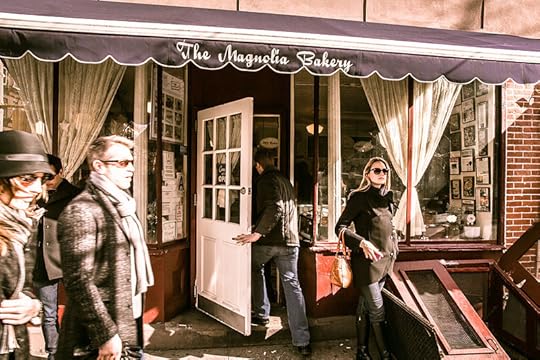 The Magnolia in January 2013, with the stairs to the meters on the right.
The Magnolia in January 2013, with the stairs to the meters on the right.WestportWiki The meters are accessed by stairs going down from the Bleecker Street sidewalk in front of the Magnolia Bakery. Several times I have made this perilous descent, often banging my head as I did so, needing access to our meter so I could flick a switch and restore power to our apartment. The meters are on the wall immediately to the left as you go down the stairs, and to reach them you usually have to remove a pile of empty cartons that block your way. The cartons are from deliveries to the Magnolia, and one hopes that, being inflammable, they won’t be there long. Another passageway leads deeper into the basement, but I have never explored it, being eager to leave this dim underworld and get back up to the land of the living.
Sitting at my desk by a window, I have a good view out over the rooftops of the adjacent buildings facing on Bleecker Street. In the distance I once saw the Twin Towers rising, then later the smoky pall of their demise, and today the Freedom Tower, which I call the Tower of Light. I have seen rooftop parties, too, and workmen building a rooftop garden, and the towering flames that one night destroyed that garden. And once I saw a young woman clad only in a bath towel appear on a roof three buildings away and come rushing across the roofs, obviously frightened. Seeing me, she begged to be let in, so Bob and I let her in and shut the window behind her. She then explained that, just out of the shower, she heard the doorbell ring, and when, expecting a delivery, she opened the door a crack to receive a package and sign for it, she saw a strange man in rags who pushed his way into her apartment. Alarmed, she fled to the roof and so came to us. We gave her a bathrobe and slippers and then offered to call 911, but instead she asked me to accompany her downstairs so she could flag down a cruising police car. She did indeed find a police car, thanked me for my help, and went with the police to her apartment. Later she came to our apartment fully clothed, returned the bathrobe and slippers, and explained that the man in her apartment was a homeless man with mental problems, very confused; the police had taken him into custody. Later a huge bouquet of flowers was delivered to our apartment by way of thanks.
Time and age claimed St. John Terrell, just as it had claimed his mother before him. His brain got foggy, he at times had a childlike look on his face, and he was no longer able to manage the building. “Talking to my husband,” his wife told me by phone, “is like talking to the air.” When he died in 1998, he rated an obit in the Times and other publications that chronicled his cultural contributions and said nothing of his role as a landlord. From them we learned that, Chicago-born, he had been the first Jack Armstrong on the radio, where as a child I may well have heard him, and a fire-eater in a carnival at age 16.
His widow continued to struggle with the malfunctioning boiler, on which she spent a small fortune, and finally she sold the building to its present owner, Margules Properties, a significant figure in Manhattan real estate who instituted a host of reforms: a lock on the outer vestibule door; an intercom, so tenants can see who is buzzing their bell; an indoor area for trash, to avoid fines from the city for trash spilling out of overfull cans on the sidewalk; renovation of the brick walls, a new roof, and new south-facing windows in our apartment; and a functioning super. And, thank God, a new boiler.
Over the years other tenants came and went, Yuppies who moved in and out so frequently that we barely had time to get to know them. I say “Yuppies” with no malign intent, for upwardly mobile professionals are what Manhattan is all about, and, given the ever higher rents, nonstabilized tenants are not likely to stick around, if something better comes their way. But on one occasion our neighbor Julie, whose cat I delighted to debauch with catnip harvested while I was hiking on the Palisades, moved out leaving the rent unpaid, as did her sister and brother-in-law downstairs, the brother-in-law being a law student steeped in the niceties of housing regulations and the law. And whenever a tenant moved out, workmen came to replaster the walls and lay down a bright new floor, even when the old floor gleamed in varnished perfection, since implementing these improvements meant another hike in the rent.
The two ground-floor commercial spaces facing on Bleecker Street have their history as well, with one tenant following another over the years. Where Bond no. 9 now marshals an array of square-shouldered little bottles of pricey scents, there was once a bookstore selling used books; the proprietor sat quietly on a stool reading into the depths of the night, seemingly unconcerned if no customers appeared. And returning late one afternoon, I noticed a lot of parked police cars and a hint of excitement in the air, but thought no more about it. Later I learned that the new tenant of a clothing store in the corner shop where Magnolia now reigns had hanged himself in his shop. He had evidently come from another site where he had been wiped out by a fire and, having no fire insurance, was deeply depressed. In 1982 that same corner site saw the opening of Bird Jungle, whose parrots and macaws and parakeets screeched noisily when being fed at 6 a.m., to the discomfort of our friend Joe, lodged in Rita’s apartment right above. Managing the store were a Wall Street insurance broker and his wife, and their birds were a colorful bunch, so colorful that I went in several times just to look at them. Uncaged and jutting their curved beaks merrily, some of them managed a few phrases like “Hello” and “I love you”; at times they even perched on a customer’s shoulder. In no time the shop became famous, though its prices ranged from $20 for a domestic to several thousand for an exotic.
 Our neighbors ... for a while: a scarlet macaw and a white-throated toucan.
Our neighbors ... for a while: a scarlet macaw and a white-throated toucan.Luis Miguel Bugallo Sánchez Bird Jungle was there for years but finally took flight, and in 1996 the Magnolia moved in. “Sex and the City” followed, fame was achieved, and visitors even from distant and alien climes began flocking, taking selfies outside before entering to procure one of Magnolia’s renowned cupcakes, and then often sitting on our doorstep to gobble their goodies. So there you have it: from screeching curved beaks and bright colors to silent sugary goodies on our doorstep. And the crowds are still coming. If earlier phases of 286 West 11th, often overlapping, could be labeled the Crime Phase, the AIDS Phase, the Boiler Phase, and the Bird Phase, since 1996 we have been in the Magnolia Phase and are likely to remain there indefinitely.
The Magnolia’s continuing presence reassures me, since Bleecker is now a high-rent thoroughfare lined with designer clothing shops that tempt me not at all, and whose displaced predecessors – charming little shops and restaurants chased out by rising rents – I heartily miss. So thank God for the Magnolia, and may it outlast the fancy stores on Bleecker. And well it may, for walking down Bleecker toward Seventh Avenue recently I counted at least ten RETAIL SPACE AVAILABLE signs on one side of the street alone, nourishing glimmers of hope that the local high-rent bubble may be about to burst. At least, I can hope.
BROWDERBOOKS
All books are available online as indicated, or from the author.
No Place for Normal: New York / Stories from the Most Exciting City in the World (Mill City Press, 2015). Winner of the Tenth Annual National Indie Excellence Award for Regional Non-Fiction; first place in the Travel category of the 2015-2016 Reader Views Literary Awards; and Honorable Mention in the Culture category of the Eric Hoffer Book Awards for 2016. All about anything and everything New York: alcoholics, abortionists, greenmarkets, Occupy Wall Street, the Gay Pride Parade, my mugging in Central Park, peyote visions, and an artist who made art of a blackened human toe. In her Reader Views review, Sheri Hoyte called it "a delightful treasure chest full of short stories about New York City."
If you love the city (or hate it), this may be the book for you. An award winner, it sold well at BookCon 2017.
Available from Amazon and Barnes & Noble.

Bill Hope: His Story (Anaphora Literary Press, 2017), the second novel in the Metropolis series. New York City, 1870s: From his cell in the gloomy prison known as the Tombs, young Bill Hope spills out in a torrent of words the story of his career as a pickpocket and shoplifter; his brutal treatment at Sing Sing and escape from another prison in a coffin; his forays into brownstones and polite society; and his sojourn among the “loonies” in a madhouse, from which he emerges to face betrayal and death threats, and possible involvement in a murder. Driving him throughout is a fierce desire for better, a persistent and undying hope.
For readers who like historical fiction and a fast-moving story.

For six LibraryThing prepublication reviews of Bill Hope: His Story, go here and scroll down.
The Pleasuring of Men (Gival Press, 2011), the first novel in the Metropolis series, tells the story of a respectably raised young man who chooses to become a male prostitute in late 1860s New York and falls in love with his most difficult client.
What was the gay scene like in nineteenth-century New York? Gay romance, if you like, but no porn (I don't do porn). Women have read it and reviewed it. (The cover illustration doesn't hurt.)
For Goodreads reviews, go here. Likewise available from Amazon and Barnes & Noble.

Coming soon: Books That Change the World. The Fountainhead, The Miserables, and Uncle Tom. Or maybe: WHY I LOVE NEW YORK.
© 2017 Clifford Browder
Published on July 23, 2017 04:37
July 16, 2017
309. Apothecaries
Now in the works: Dark Knowledge, about New York City and the slave trade.
More of this anon. Now let's have a look at apothecaries.
In the big storefront window all kinds of antique scales, both large and small, for weighing things, one of them in a big glass case. Glass tubes and receptacles, probably used to distill medications. One big mortar and pestle and one small one. A legion of small brown bottles, and larger wide-mouthed apothecary jars with glass stoppers and bold labels reading
CARDAMUMCAMPHORAMMONIUM CHLORIDEZINC OXIDEALUMRHUBARB AND SODA MIXTUREBELLADONNA
A row of time-worn books, one conspicuously labeled Elements of Chemistry. Two thick, massive volumes brown with age, open to pages with scores of prescriptions affixed, scribbled in a near-indecipherable hand, their dates not visible, but probably dating from the early twentieth century. The whole display fascinating, puzzling, reeking with history and age.
 Apothecary jars
Apothecary jars
Such is the current window display of Grove Drugs at 302 West 12th Street, whose window and entrance are on Eighth Avenue but a couple of blocks from my apartment. One of the few independent pharmacies left in the West Village, where chain stores dominate, Grove typically provides window displays of unusual interest, but this one, a repeat of a display two years ago that was chronicled in this blog, fascinates. When I asked inside about the source of the earlier display, I was told that these objects had been found in the basement of the Avignone Chemists at Bleecker Street and Sixth Avenue, now closed, whose antecedents had gone back a century or more. Discovered during a renovation in 2007, these relics of the past had not been discarded but preserved, and now, when displayed, they give us a glimpse of the pharmaceutical past, when the time-honored apothecary shop prevailed.
(Note: The word "apothecary" can designate either the practitioner or the practitioner's shop. To avoid confusion, I use "apothecary" for the person, and "apothecary shop" for the shop.)
The profession of apothecary dates back to antiquity and differs from that of pharmacists today. Pharmacies today are well stocked with over-the-counter products, mass-produced by pharmaceutical companies, that come in standardized dosages formulated to meet the needs of the average user. But in earlier times the apothecary created medications individually for each customer, who received a product specific to his or her needs. In theory, the apothecary had some knowledge of chemistry, but at first there was little regulation.
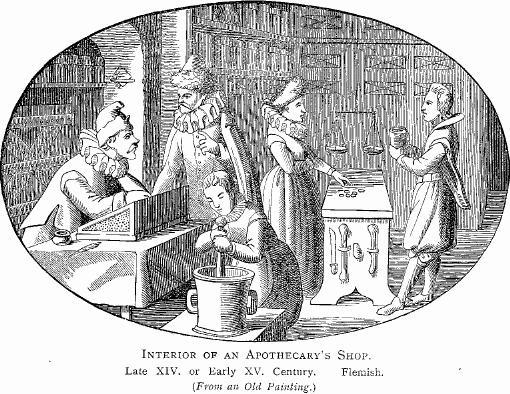 Apothecary shop in fifteenth-century France.
Apothecary shop in fifteenth-century France.
 A 17th-century German apothecary.Welcome Library The objects on display in Grove’s window hearken back to this early period when the apothecary made compounds from ingredients like those in the bottles and jars displayed, grinding them to a powder with a mortar and pestle, weighing them with scales to get the right measure, or distilling them with the glass paraphernalia seen in the window to make a tincture, lotion, volatile oil, or perfume. The one thing typical of the old apothecary shops that the display can’t reproduce is the aroma, a strange mix of spices, perfumes, camphor, castor oil, and other soothing or astringent remedies. Mercifully absent as well is a jar with live leeches, since by the late nineteenth century the time-honored practice of bloodletting, which probably killed more patients than it benefited, had been discontinued.
A 17th-century German apothecary.Welcome Library The objects on display in Grove’s window hearken back to this early period when the apothecary made compounds from ingredients like those in the bottles and jars displayed, grinding them to a powder with a mortar and pestle, weighing them with scales to get the right measure, or distilling them with the glass paraphernalia seen in the window to make a tincture, lotion, volatile oil, or perfume. The one thing typical of the old apothecary shops that the display can’t reproduce is the aroma, a strange mix of spices, perfumes, camphor, castor oil, and other soothing or astringent remedies. Mercifully absent as well is a jar with live leeches, since by the late nineteenth century the time-honored practice of bloodletting, which probably killed more patients than it benefited, had been discontinued.
The apothecary’s remedies were derived sometimes from folk medicine and sometimes from published compendiums. Chalk was used for heartburn, calamine for skin irritations, spearmint for stomachache, rose petals steeped in vinegar for headaches, and cinchona bark for fevers. Often serving as a physician, the apothecary applied garlic poultices to sores and wounds and rheumatic limbs. Laudanum, or opium tincture, was employed freely, with little regard to its addictiveness, to treat ulcers, bruises, and inflamed joints, and was taken internally to alleviate pain. Little wonder that well-bred ladies became addicted, like Eugene O’Neill’s mother, as memorably portrayed in his autobiographical play A Long Day’s Journey into Night. But if some of these remedies seem fanciful or naïve or even dangerous, others are known to work even today, as for example witch hazel for hemorrhoids.
But medicines weren’t the only products of an apothecary shop. Rose petals, jasmine, and gardenias might be distilled to create perfumes, and lavender, honey, and beeswax were compounded to create face creams to enhance the milk-white complexion desired by ladies of the nineteenth centuries, when the sun tan so prized today characterized a market woman or farmer’s wife, lower-caste females who had to work outdoors for a living. (The prime defense against the sun was, of course, the parasol, without which no Victorian lady ventured outdoors.) A fragrant pomade for the hair was made of soft beef fat, essence of violets, jasmine, and oil of bergamot, and cosmetic gloves rubbed on the inside with spermaceti, balsam of Peru, and oil of nutmeg and cassia were worn by ladies in bed at night, to soften and bleach the hands, and to prevent chapped hands and chilblains.
But the apothecary’s products were not without risks. Face powders might contain arsenic; belladonna, a known poison, was used to widen the pupils of the eyes; and bleaching agents included ammonia, quicksilver, spirits of turpentine, and tar. All of which suggests a less than competent grasp of basic chemistry. And in the flavored syrups and sodas devised to mask the unpleasant medicinal taste of prescriptions, two common ingredients were cocaine and alcohol, which must have induced in the patients an unwonted buoyancy of spirits.
 Marketed especially for children.
Marketed especially for children.
Also available in an apothecary shop were cooking spices, candles, soap, salad oil, toothbrushes, combs, cigars, and tobacco, so that it in some ways approximated the general store of the time. And in the eighteenth century American apothecaries also made house calls, trained apprentices, performed surgery, and acted as male midwives.
 Belladonna, which appears in the Grove Drugs window display, merits a mention of its own. The name means “beautiful lady” in Italian, for the juice of its berry was used by Italian women in the Renaissance to dilate the pupils of their eyes so as to appear more seductive. A sinister and risky beauty resulted, for this small shrub that grows in many parts of the world, including North America, produces leaves and berries that are extremely toxic, as indicated by its other common name, “deadly nightshade.” It has long been known as a medicine, poison, and cosmetic. Nineteenth-century medicine used it to alleviate pain, relax the muscles, and treat inflammation, and it is still in use today as a sedative to stop bronchial spasms, and also to treat Parkinson’s, rheumatism, and other ailments.
Belladonna, which appears in the Grove Drugs window display, merits a mention of its own. The name means “beautiful lady” in Italian, for the juice of its berry was used by Italian women in the Renaissance to dilate the pupils of their eyes so as to appear more seductive. A sinister and risky beauty resulted, for this small shrub that grows in many parts of the world, including North America, produces leaves and berries that are extremely toxic, as indicated by its other common name, “deadly nightshade.” It has long been known as a medicine, poison, and cosmetic. Nineteenth-century medicine used it to alleviate pain, relax the muscles, and treat inflammation, and it is still in use today as a sedative to stop bronchial spasms, and also to treat Parkinson’s, rheumatism, and other ailments.
Belladonna figures often in history and legend. It is said that Livia, the wife of the Roman emperor Augustus, used it to kill her husband. And in folklore, witches used a mixture of belladonna, opium, and other poisons to help them fly to conclaves of witches called sabbaths, where participants did naughty things, danced wildly, and kissed the devil’s behind. The shiny black berries have been called “murderer’s berries,” “sorcerer’s berries,” and “devil’s berries.”
All in all, not a plant to mess with, although a staple in most apothecary shops of former times. If you think you’ve never gone near it, think again, for if you’ve ever had your eyes dilated, belladonna is in the eye drops. And I’ll admit that the name intrigues me: belladonna, the beautiful lady who poisons. Which brings us back to the Empress Livia; maybe she did do the old boy in.
Gradually, the professions of apothecary and pharmacist -- never quite distinct – became more organized, then regulated. In the nineteenth century patent medicines (which were not patented) became big business, thanks to advertising, but their mislabeling of ingredients and their extravagant claims inspired a growing desire for regulation that finally resulted in the Pure Food and Drug Act of 1906. This and subsequent legislation probably benefited apothecaries, since mass-produced patent medicines competed with their products.
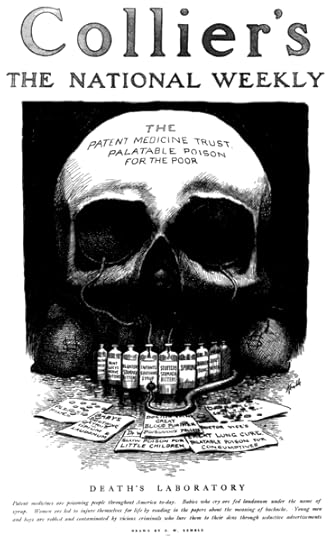 The cover of Collier's magazine of June 3, 1905, which contained an exposé of patent medicines.
The cover of Collier's magazine of June 3, 1905, which contained an exposé of patent medicines.
As late as the 1930s and 1940s, apothecaries still compounded some 60% of all U.S. medications. In the years following World War II, however, the growth of commercial drug manufacturers signaled the decline of the medicine-compounding apothecary, just as the use of the mortar and pestle diminished to the point of becoming a quaint and charming symbol of a bygone era. In 1951 new federal legislation introduced doctor-only legal status for most medicines, and from then on the modern pharmacist prevailed, dispensing manufactured drugs.
By the 1980s large chain drugstores had come to dominate the pharmaceutical sales market, rendering the survival of the independent neighborhood pharmacy precarious. Yet some of them do survive, and when one closes, the whole neighborhood mourns. But in a final twist, the word “apothecary,” meaning a place of business rather than a medicine compounder, has become “hip” and “in,” appearing in names of businesses having nothing to do with medicines. It expresses a nostalgia for experience free from technology and characterized by creativity and a personal touch, a longing for Old World tradition and gentility. And as one observer has commented, “apothecary” is fun to say.
BROWDERBOOKS
All books are available online as indicated, or from the author.
No Place for Normal: New York / Stories from the Most Exciting City in the World (Mill City Press, 2015). Winner of the Tenth Annual National Indie Excellence Award for Regional Non-Fiction; first place in the Travel category of the 2015-2016 Reader Views Literary Awards; and Honorable Mention in the Culture category of the Eric Hoffer Book Awards for 2016. All about anything and everything New York: alcoholics, abortionists, greenmarkets, Occupy Wall Street, the Gay Pride Parade, my mugging in Central Park, peyote visions, and an artist who made art of a blackened human toe. In her Reader Views review, Sheri Hoyte called it "a delightful treasure chest full of short stories about New York City."
If you love the city (or hate it), this may be the book for you. An award winner, it sold well at BookCon 2017.
Available from Amazon and Barnes & Noble.

Bill Hope: His Story (Anaphora Literary Press, 2017), the second novel in the Metropolis series. New York City, 1870s: From his cell in the gloomy prison known as the Tombs, young Bill Hope spills out in a torrent of words the story of his career as a pickpocket and shoplifter; his brutal treatment at Sing Sing and escape from another prison in a coffin; his forays into brownstones and polite society; and his sojourn among the “loonies” in a madhouse, from which he emerges to face betrayal and death threats, and possible involvement in a murder. Driving him throughout is a fierce desire for better, a persistent and undying hope.
For readers who like historical fiction and a fast-moving story.

For six LibraryThing prepublication reviews of Bill Hope: His Story, go here and scroll down.
The Pleasuring of Men (Gival Press, 2011), the first novel in the Metropolis series, tells the story of a respectably raised young man who chooses to become a male prostitute in late 1860s New York and falls in love with his most difficult client.
What was the gay scene like in nineteenth-century New York? Gay romance, if you like, but no porn (I don't do porn). Women have read it and reviewed it. (The cover illustration doesn't hurt.)
For Goodreads reviews, go here. Likewise available from Amazon and Barnes & Noble.

Coming soon: The annals of 286 West 11th Street, my building. Two fires, a suicide, a scream in the night, Washington crossing the Delaware (yes, there is a connection), and a jungle of toucans and macaws.
© 2017 Clifford Browder
More of this anon. Now let's have a look at apothecaries.
In the big storefront window all kinds of antique scales, both large and small, for weighing things, one of them in a big glass case. Glass tubes and receptacles, probably used to distill medications. One big mortar and pestle and one small one. A legion of small brown bottles, and larger wide-mouthed apothecary jars with glass stoppers and bold labels reading
CARDAMUMCAMPHORAMMONIUM CHLORIDEZINC OXIDEALUMRHUBARB AND SODA MIXTUREBELLADONNA
A row of time-worn books, one conspicuously labeled Elements of Chemistry. Two thick, massive volumes brown with age, open to pages with scores of prescriptions affixed, scribbled in a near-indecipherable hand, their dates not visible, but probably dating from the early twentieth century. The whole display fascinating, puzzling, reeking with history and age.
 Apothecary jars
Apothecary jarsSuch is the current window display of Grove Drugs at 302 West 12th Street, whose window and entrance are on Eighth Avenue but a couple of blocks from my apartment. One of the few independent pharmacies left in the West Village, where chain stores dominate, Grove typically provides window displays of unusual interest, but this one, a repeat of a display two years ago that was chronicled in this blog, fascinates. When I asked inside about the source of the earlier display, I was told that these objects had been found in the basement of the Avignone Chemists at Bleecker Street and Sixth Avenue, now closed, whose antecedents had gone back a century or more. Discovered during a renovation in 2007, these relics of the past had not been discarded but preserved, and now, when displayed, they give us a glimpse of the pharmaceutical past, when the time-honored apothecary shop prevailed.
(Note: The word "apothecary" can designate either the practitioner or the practitioner's shop. To avoid confusion, I use "apothecary" for the person, and "apothecary shop" for the shop.)
The profession of apothecary dates back to antiquity and differs from that of pharmacists today. Pharmacies today are well stocked with over-the-counter products, mass-produced by pharmaceutical companies, that come in standardized dosages formulated to meet the needs of the average user. But in earlier times the apothecary created medications individually for each customer, who received a product specific to his or her needs. In theory, the apothecary had some knowledge of chemistry, but at first there was little regulation.
 Apothecary shop in fifteenth-century France.
Apothecary shop in fifteenth-century France. A 17th-century German apothecary.Welcome Library The objects on display in Grove’s window hearken back to this early period when the apothecary made compounds from ingredients like those in the bottles and jars displayed, grinding them to a powder with a mortar and pestle, weighing them with scales to get the right measure, or distilling them with the glass paraphernalia seen in the window to make a tincture, lotion, volatile oil, or perfume. The one thing typical of the old apothecary shops that the display can’t reproduce is the aroma, a strange mix of spices, perfumes, camphor, castor oil, and other soothing or astringent remedies. Mercifully absent as well is a jar with live leeches, since by the late nineteenth century the time-honored practice of bloodletting, which probably killed more patients than it benefited, had been discontinued.
A 17th-century German apothecary.Welcome Library The objects on display in Grove’s window hearken back to this early period when the apothecary made compounds from ingredients like those in the bottles and jars displayed, grinding them to a powder with a mortar and pestle, weighing them with scales to get the right measure, or distilling them with the glass paraphernalia seen in the window to make a tincture, lotion, volatile oil, or perfume. The one thing typical of the old apothecary shops that the display can’t reproduce is the aroma, a strange mix of spices, perfumes, camphor, castor oil, and other soothing or astringent remedies. Mercifully absent as well is a jar with live leeches, since by the late nineteenth century the time-honored practice of bloodletting, which probably killed more patients than it benefited, had been discontinued.The apothecary’s remedies were derived sometimes from folk medicine and sometimes from published compendiums. Chalk was used for heartburn, calamine for skin irritations, spearmint for stomachache, rose petals steeped in vinegar for headaches, and cinchona bark for fevers. Often serving as a physician, the apothecary applied garlic poultices to sores and wounds and rheumatic limbs. Laudanum, or opium tincture, was employed freely, with little regard to its addictiveness, to treat ulcers, bruises, and inflamed joints, and was taken internally to alleviate pain. Little wonder that well-bred ladies became addicted, like Eugene O’Neill’s mother, as memorably portrayed in his autobiographical play A Long Day’s Journey into Night. But if some of these remedies seem fanciful or naïve or even dangerous, others are known to work even today, as for example witch hazel for hemorrhoids.
But medicines weren’t the only products of an apothecary shop. Rose petals, jasmine, and gardenias might be distilled to create perfumes, and lavender, honey, and beeswax were compounded to create face creams to enhance the milk-white complexion desired by ladies of the nineteenth centuries, when the sun tan so prized today characterized a market woman or farmer’s wife, lower-caste females who had to work outdoors for a living. (The prime defense against the sun was, of course, the parasol, without which no Victorian lady ventured outdoors.) A fragrant pomade for the hair was made of soft beef fat, essence of violets, jasmine, and oil of bergamot, and cosmetic gloves rubbed on the inside with spermaceti, balsam of Peru, and oil of nutmeg and cassia were worn by ladies in bed at night, to soften and bleach the hands, and to prevent chapped hands and chilblains.
But the apothecary’s products were not without risks. Face powders might contain arsenic; belladonna, a known poison, was used to widen the pupils of the eyes; and bleaching agents included ammonia, quicksilver, spirits of turpentine, and tar. All of which suggests a less than competent grasp of basic chemistry. And in the flavored syrups and sodas devised to mask the unpleasant medicinal taste of prescriptions, two common ingredients were cocaine and alcohol, which must have induced in the patients an unwonted buoyancy of spirits.
 Marketed especially for children.
Marketed especially for children.Also available in an apothecary shop were cooking spices, candles, soap, salad oil, toothbrushes, combs, cigars, and tobacco, so that it in some ways approximated the general store of the time. And in the eighteenth century American apothecaries also made house calls, trained apprentices, performed surgery, and acted as male midwives.
 Belladonna, which appears in the Grove Drugs window display, merits a mention of its own. The name means “beautiful lady” in Italian, for the juice of its berry was used by Italian women in the Renaissance to dilate the pupils of their eyes so as to appear more seductive. A sinister and risky beauty resulted, for this small shrub that grows in many parts of the world, including North America, produces leaves and berries that are extremely toxic, as indicated by its other common name, “deadly nightshade.” It has long been known as a medicine, poison, and cosmetic. Nineteenth-century medicine used it to alleviate pain, relax the muscles, and treat inflammation, and it is still in use today as a sedative to stop bronchial spasms, and also to treat Parkinson’s, rheumatism, and other ailments.
Belladonna, which appears in the Grove Drugs window display, merits a mention of its own. The name means “beautiful lady” in Italian, for the juice of its berry was used by Italian women in the Renaissance to dilate the pupils of their eyes so as to appear more seductive. A sinister and risky beauty resulted, for this small shrub that grows in many parts of the world, including North America, produces leaves and berries that are extremely toxic, as indicated by its other common name, “deadly nightshade.” It has long been known as a medicine, poison, and cosmetic. Nineteenth-century medicine used it to alleviate pain, relax the muscles, and treat inflammation, and it is still in use today as a sedative to stop bronchial spasms, and also to treat Parkinson’s, rheumatism, and other ailments. Belladonna figures often in history and legend. It is said that Livia, the wife of the Roman emperor Augustus, used it to kill her husband. And in folklore, witches used a mixture of belladonna, opium, and other poisons to help them fly to conclaves of witches called sabbaths, where participants did naughty things, danced wildly, and kissed the devil’s behind. The shiny black berries have been called “murderer’s berries,” “sorcerer’s berries,” and “devil’s berries.”
All in all, not a plant to mess with, although a staple in most apothecary shops of former times. If you think you’ve never gone near it, think again, for if you’ve ever had your eyes dilated, belladonna is in the eye drops. And I’ll admit that the name intrigues me: belladonna, the beautiful lady who poisons. Which brings us back to the Empress Livia; maybe she did do the old boy in.
Gradually, the professions of apothecary and pharmacist -- never quite distinct – became more organized, then regulated. In the nineteenth century patent medicines (which were not patented) became big business, thanks to advertising, but their mislabeling of ingredients and their extravagant claims inspired a growing desire for regulation that finally resulted in the Pure Food and Drug Act of 1906. This and subsequent legislation probably benefited apothecaries, since mass-produced patent medicines competed with their products.
 The cover of Collier's magazine of June 3, 1905, which contained an exposé of patent medicines.
The cover of Collier's magazine of June 3, 1905, which contained an exposé of patent medicines.As late as the 1930s and 1940s, apothecaries still compounded some 60% of all U.S. medications. In the years following World War II, however, the growth of commercial drug manufacturers signaled the decline of the medicine-compounding apothecary, just as the use of the mortar and pestle diminished to the point of becoming a quaint and charming symbol of a bygone era. In 1951 new federal legislation introduced doctor-only legal status for most medicines, and from then on the modern pharmacist prevailed, dispensing manufactured drugs.
By the 1980s large chain drugstores had come to dominate the pharmaceutical sales market, rendering the survival of the independent neighborhood pharmacy precarious. Yet some of them do survive, and when one closes, the whole neighborhood mourns. But in a final twist, the word “apothecary,” meaning a place of business rather than a medicine compounder, has become “hip” and “in,” appearing in names of businesses having nothing to do with medicines. It expresses a nostalgia for experience free from technology and characterized by creativity and a personal touch, a longing for Old World tradition and gentility. And as one observer has commented, “apothecary” is fun to say.
BROWDERBOOKS
All books are available online as indicated, or from the author.
No Place for Normal: New York / Stories from the Most Exciting City in the World (Mill City Press, 2015). Winner of the Tenth Annual National Indie Excellence Award for Regional Non-Fiction; first place in the Travel category of the 2015-2016 Reader Views Literary Awards; and Honorable Mention in the Culture category of the Eric Hoffer Book Awards for 2016. All about anything and everything New York: alcoholics, abortionists, greenmarkets, Occupy Wall Street, the Gay Pride Parade, my mugging in Central Park, peyote visions, and an artist who made art of a blackened human toe. In her Reader Views review, Sheri Hoyte called it "a delightful treasure chest full of short stories about New York City."
If you love the city (or hate it), this may be the book for you. An award winner, it sold well at BookCon 2017.
Available from Amazon and Barnes & Noble.

Bill Hope: His Story (Anaphora Literary Press, 2017), the second novel in the Metropolis series. New York City, 1870s: From his cell in the gloomy prison known as the Tombs, young Bill Hope spills out in a torrent of words the story of his career as a pickpocket and shoplifter; his brutal treatment at Sing Sing and escape from another prison in a coffin; his forays into brownstones and polite society; and his sojourn among the “loonies” in a madhouse, from which he emerges to face betrayal and death threats, and possible involvement in a murder. Driving him throughout is a fierce desire for better, a persistent and undying hope.
For readers who like historical fiction and a fast-moving story.

For six LibraryThing prepublication reviews of Bill Hope: His Story, go here and scroll down.
The Pleasuring of Men (Gival Press, 2011), the first novel in the Metropolis series, tells the story of a respectably raised young man who chooses to become a male prostitute in late 1860s New York and falls in love with his most difficult client.
What was the gay scene like in nineteenth-century New York? Gay romance, if you like, but no porn (I don't do porn). Women have read it and reviewed it. (The cover illustration doesn't hurt.)
For Goodreads reviews, go here. Likewise available from Amazon and Barnes & Noble.

Coming soon: The annals of 286 West 11th Street, my building. Two fires, a suicide, a scream in the night, Washington crossing the Delaware (yes, there is a connection), and a jungle of toucans and macaws.
© 2017 Clifford Browder
Published on July 16, 2017 04:50
July 9, 2017
308. Waldorf-Astoria
Did you know that New York City, that supposed citadel of liberalism and progressive ideas, was the center of the illegal pre-Civil War slave trade, taking slaves from Africa to Cuba? Many in the city didn't realize this, but those on the waterfront knew. More about this soon.
And now, on to the Waldorf and its latest phase.
It was just by chance that I noticed the tiny squib of an ad in the lower right corner of the last page of the New York Times Sunday Business section of June 25, 2017:
1000 ROOMS – 1000 ROOMS – 1000 ROOMS WALDORF ASTORIA HOTEL (10) Kitchs Fully Loaded w/All Refrigs & Cooking Equip, (1000’s) Pieces Smallwares, (10) Walkin Boxes, (100’s) Racks, Too Much To List, Rooms Incl. Suites, Singles, Doubles, Etc. DO NOT MISS THIS SALE! BY APPOINTMENT ONLY – CALL AUCTIONEER
And this reproduction of it enlarges the print and makes it more conspicuous than it was.
I was shocked. Were the furnishings of the rooms of the fabulous, legendary, illustrious Waldorf Astoria Hotel of Park Avenue being auctioned off? And the sale announced here where only veteran auction seekers would think to look for it, squeezed in between a Large Like New PIZZA RESTAURANT and a Fully Equipped FISH MARKET?
 The Waldorf, with St. Bartholomew's Episcopal church in the foreground.
The Waldorf, with St. Bartholomew's Episcopal church in the foreground.Reading Tom
Alas, it was only too true. A Times article of February 25, 2017, was captioned End of an Era Looms as Waldorf Astoria Prepares to Close for Renovations. And under this banner caption, in less bold type: “A Storied Hotel, / Now a Bit Shabby.” The Waldorf, shabby? Another shocker. Time wreaks its havoc on us all, but it had never occurred to me that the Waldorf might yield to its ravages.
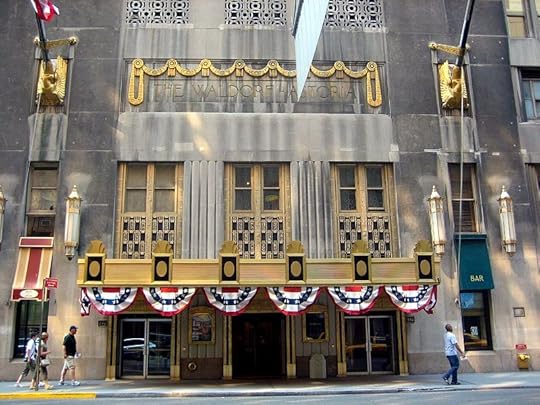 The Park Avenue entrance in 2008.
The Park Avenue entrance in 2008.Jordi Sabaté
In 2014 the hotel’s owner, Hilton Worldwide Holdings, sold it for the stratospheric price of $1.95 billion (yes: billion) to the Anbang Insurance Group, a Chinese company with ties to Beijing’s ruling elite. Which in itself is enough to revive desperate warnings of the land of the free threatened by the insidious Yellow Peril. Admittedly, patrons staying there in recent years have noticed worn carpeting, scratched and dented room furniture, and less than stellar food, so it’s not surprising that the new owners are undertaking major renovations. But the hotel is being shut down for two or three years for what amounts to a radical transformation, since it will reopen as a smaller hotel with more apartments. The Waldorf Towers, accessed through a separate entrance, has been a suites-only address with longtime residents ever since the Waldorf opened in 1931, but now there will be more apartments in the form of condominiums, though how many, and at what price, has not been announced. But this is clearly the end of an era, and news of it brought guests from distant states places to enjoy, regardless of the cost, a last chance to savor the fabled luxury of the legendary hostelry.
And what an era it was! Even I have trod its elegant halls, traversing an arcade that went from Lexington Avenue to Park simply to enjoy its elegance. Ending up in the fabled Park Avenue lobby, with its Wheel-of-Life marble mosaic in the floor, and its clock tower topped by a miniature gilded Statue of Liberty, I would linger briefly to hear harp music drifting magically down from a harpist on an alcove or balcony above.
But that experience gives only a hint of the Waldorf’s mystique. This is a hotel that· Opened in 1931, in the Depression, as the biggest, tallest, and most expensive hotel ever built· Had 2200 rooms, 47 stories, and construction costs of over $40 million· Hosted every president from Herbert Hoover on, as well as Muhammad Ali, the Dalai Lama, and other notables· Hosted the annual Al Smith Dinner, a gala occasion to benefit Catholic charities· Hosted elegant balls for scores of debutantes radiant in virginal white, and their tux-clad escorts, in the Grand Ballroom· Created eggs Benedict, veal Oscar, red velvet cupcakes, Thousand Island dressing, and the Waldorf salad, tasting which, when my mother served it to me as a mix of sliced apples, walnuts, celery, and raisins, gave me my first dim awareness of the hotel
 The Waldorf salad, which I still ingest.
The Waldorf salad, which I still ingest.KaMan· Welcomed as residents in the luxurious Waldorf Towers ex-president Herbert Hoover (a 30-year resident), Cole Porter, Prince Rainier and Princess Grace of Monaco, Frank Sinatra, Elizabeth Taylor, party-giver Elsa Maxwell, and General Douglas MacArthur, whose young son Arthur issued from these storied premises to attend my second-year French class at Columbia College (the closest I ever got to the General) in 1957· Hosted in room 39D of the Towers, under the name Charles Ross, the notorious mobster Lucky Luciano, who sported custom-made suits, silk shirts, and cashmere topcoats until, in 1936, a friendly Waldorf clerk warned him that detectives were coming up to arrest him, at which point he decamped for Hot Springs, Arkansas, amid whose healing thermal waters he was finally apprehended
[image error] Download
all sizes
 Use this file
Use this file
on the web
 Use this file
Use this file
on a wiki
 Email a link
Email a link
to this file
 Information
Information
about reusing

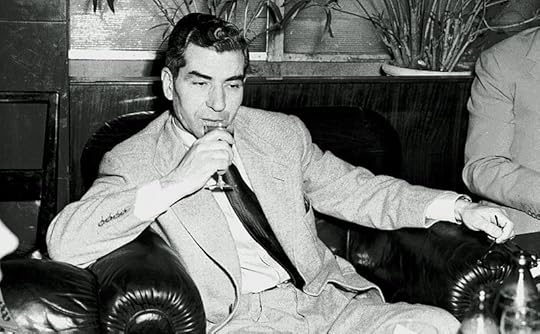 Mr. Luciano, a onetime Waldorf guest.
Mr. Luciano, a onetime Waldorf guest.· Hosted the celebrity-studded April in Paris Ball where, in April 1957, the sudden appearance of party-giver Elsa Maxwell and her newfound friend Marilyn Monroe, the most sought-after blonde on the planet, provoked a rush to their table of photographers, to the chagrin of the now deserted Duchess of Windsor, honorary chair of the affair, with whom Elsa had long been feuding.
 Elsa and her new friend Marilyn at the April in Paris Ball, 1957.
Elsa and her new friend Marilyn at the April in Paris Ball, 1957.When the Waldorf’s closing was announced, the fate of its famous interior landmarks was undecided. In the summer of 2016, when the New York Landmarks Conservancy learned that the new owners planned to gut the building, its representatives met with Anbang executives and persuaded them to support landmark designation for such Art Deco spaces as the Park Avenue Lobby, the Main Lobby, the Peacock Alley restaurant, the four-story Grand Ballroom, the Basildon Room, the Jade Room, the John Jacob Astor Salon, the third-floor Silver Corridor, and the Starlight Roof. Aside from the Park Avenue Lobby, I have never set foot in any of these treasured spaces, but the names themselves conjure up visions of Art Deco grandeur crying out for preservation, and all but the Starlight Roof will be preserved. That being the case, I guess we can do without a few refrigerators, smallwares, and walk-in boxes.
As for the condominiums to be created by the renovation, one may well wonder whom they will attract. Moneyed foreigners, is the guess. So where such stellar Americans as Frank Sinatra, Elsa Maxwell, and Lucky Luciano once trod, or rested their dear head, we can expect Chinese billionaires, Arab princelings, and Indian plutocrats, tasty additions to the smorgasborg that is New York.
BROWDERBOOKS
All books are available online as indicated, or from the author.
No Place for Normal: New York / Stories from the Most Exciting City in the World (Mill City Press, 2015). Winner of the Tenth Annual National Indie Excellence Award for Regional Non-Fiction; first place in the Travel category of the 2015-2016 Reader Views Literary Awards; and Honorable Mention in the Culture category of the Eric Hoffer Book Awards for 2016. All about anything and everything New York: alcoholics, abortionists, greenmarkets, Occupy Wall Street, the Gay Pride Parade, my mugging in Central Park, peyote visions, and an artist who made art of a blackened human toe. In her Reader Views review, Sheri Hoyte called it "a delightful treasure chest full of short stories about New York City."
If you love the city (or hate it), this may be the book for you. An award winner, it sold well at BookCon 2017.
Available from Amazon and Barnes & Noble.

Bill Hope: His Story (Anaphora Literary Press, 2017), the second novel in the Metropolis series. New York City, 1870s: From his cell in the gloomy prison known as the Tombs, young Bill Hope spills out in a torrent of words the story of his career as a pickpocket and shoplifter; his brutal treatment at Sing Sing and escape from another prison in a coffin; his forays into brownstones and polite society; and his sojourn among the “loonies” in a madhouse, from which he emerges to face betrayal and death threats, and possible involvement in a murder. Driving him throughout is a fierce desire for better, a persistent and undying hope.
For readers who like historical fiction and a fast-moving story.

For six LibraryThing prepublication reviews of Bill Hope: His Story, go here and scroll down.
The Pleasuring of Men (Gival Press, 2011), the first novel in the Metropolis series, tells the story of a respectably raised young man who chooses to become a male prostitute in late 1860s New York and falls in love with his most difficult client.
What was the gay scene like in nineteenth-century New York? Gay romance, if you like, but no porn (I don't do porn). Women have read it and reviewed it. (The cover illustration doesn't hurt.)
For Goodreads reviews, go here. Likewise available from Amazon and Barnes & Noble.

Coming soon: Apothecaries. Chalk for heartburn, rose petals for headaches, cinchona bark for fevers -- and some of it even worked! And belladonna, the beautiful lady who poisons.
© 2017 Clifford Browder
Published on July 09, 2017 03:56
July 5, 2017
307. Lady Liberty
HUGE BIG NEWS: Yes, I still have a new book in the pipeline, details to come. Meanwhile, I continue to shamelessly hawk my other books in the BROWDERBOOKS section that follows Lady Liberty.
We take her for granted, but she wasn’t always there, and it wasn't easy getting her set up in the harbor to greet incoming passengers back before travel by air. Here, in honor of the Fourth of July, is how it happened.
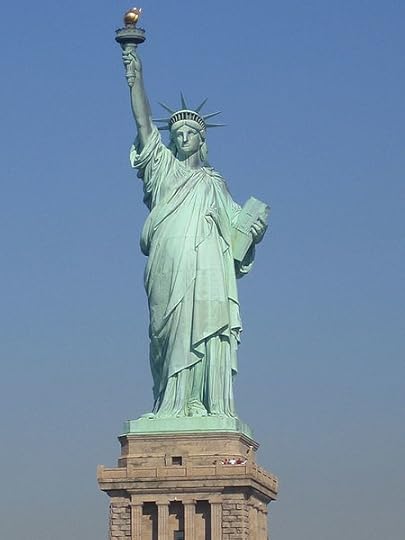 featherboa
featherboa[image error] Laboulaye The idea for the statue was the inspiration of a French legal scholar and author, Edouard René de Laboulaye, who admired the American Constitution and wanted to commemorate the federal government’s abolition of slavery. In 1865, when our Civil War ended, he established a committee to raise funds to assist the slaves in their transition to freedom, and hoped that France and America might collaborate in building a bronze colossus honoring this act of liberation. This was under the Second Empire, whose collapse in 1870 led Laboulaye and his friends to revive their somewhat neglected project, offering to design, build, and pay for the statue, if Americans would provide a suitable pedestal and location. In a time of monarchy, it would be a joint effort in the name of liberty by the two republics.
When Laboulaye’s associate the French sculptor Frédéric Bartholdi came to this country to promote the idea, he decided that the ideal location would be Bedloe’s Island, recently ceded by New York State to the federal government for military purposes. There it would greet every ship arriving in the harbor of this, the nation’s busiest port. In 1877 both President Ulysses S. Grant and his successor, Rutherford B. Hayes, authorized the construction of a monument on the island.
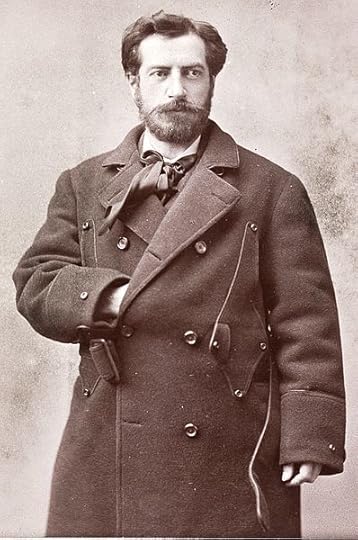 Bartholdi in 1880, looking a bit Napoleonic.
Bartholdi in 1880, looking a bit Napoleonic.A done deal? Not at all. Tired of sectional strife and overwhelmed by a severe depression brought on by the Panic of 1873, white Americans didn’t want to be reminded of the issues that had so recently and so disastrously divided them; the North, in fact, was choosing to ignore the proliferation of Jim Crow laws in the South. Also, other states were reluctant to help finance a giant bronze female that would grace the harbor of distant, oversized, and imperious New York, while New Yorkers felt too pinched by hard times to spare the needed funds for the massive granite base.
With this in mind, advocates now promoted the statue as a memorial of the hundredth anniversary of American independence, and the time-honored alliance of the French and American people. Never underestimate the energy of a bunch of American boosters eager to promote a project they fervently believe in. The fund-raising committee published articles in the press, arranged benefit performances of popular plays, and persuaded wealthy citizens to exhibit their art collections and charge admission, the proceeds going to the committee. At their suggestion, Bartholdi sent the statue’s right hand and uplifted torch, so it could be displayed at the Centennial Exhibition in Philadelphia in 1876, an honor that the Empire City grudgingly ceded to its perennial rival, the City of Brotherly Love, since that was where the Declaration of Independence had been written and approved. At the exhibition, competing with Alexander Graham Bell’s telephone, the Remington Typographic Machine (i.e., typewriter), Heinz Ketchup, Hires Root Beer, and other earth-shattering innovations, this fragment of Bartholdi’s colossus towered above the mere mortals who were allowed, for fifty cents each (proceeds going to the committee), to ascend a ladder to the observation platform just under the torch.
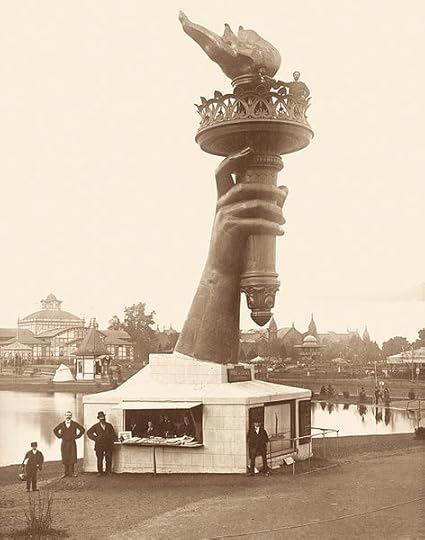 At the Centennial, 1876, with the original torch (since replaced).
At the Centennial, 1876, with the original torch (since replaced).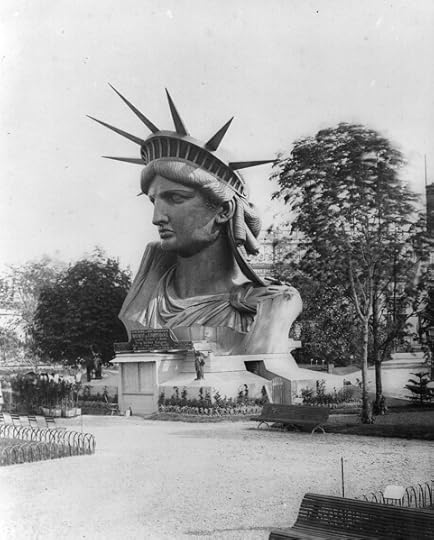 The head, on display at the Paris World's Fair, 1878.
The head, on display at the Paris World's Fair, 1878.Even so, the campaign to raise the needed funds dragged on for years, and Laboulaye died in 1883. In December of that year the statue’s promoters held an auction for which they solicited artwork and literary manuscripts that would be assembled in a portfolio with a letter from President Chester A. Arthur and other items. Among those asked to submit a poem was 34-year-old Emma Lazarus, a writer who, though from a wealthy Jewish family, had done volunteer work to help the Jewish immigrants now flocking to the U.S. from eastern Europe. The result was a sonnet entitled “The New Colossus,” the closing lines of which would in time become famous:
Not like the brazen giant of Greek fame, With conquering limbs astride from land to land; Here at our sea-washed, sunset gates shall stand A mighty woman with a torch, whose flame Is the imprisoned lightning, and her name Mother of Exiles. From her beacon-hand Glows world-wide welcome; her mild eyes command The air-bridged harbor that twin cities frame. “Keep, ancient lands, your storied pomp!” cries she With silent lips. “Give me your tired, your poor, Your huddled masses yearning to breathe free, The wretched refuse of your teeming shore. Send these, the homeless, tempest-tost to me, I lift my lamp beside the golden door!”
But the auction brought in only half the hoped-for amount, and the poem was soon forgotten. Political partisanship caused further delays, with Republicans at both state and federal level allocating funds for the pedestal, only to be blocked by Democrats. Packed away in over 200 crates in a European warehouse, the statue gathered dust; the French people, having paid to have it cast, grew bitter; and Boston and Philadelphia promised to build a pedestal at once, should the statue come to them. It was not New York’s finest hour.
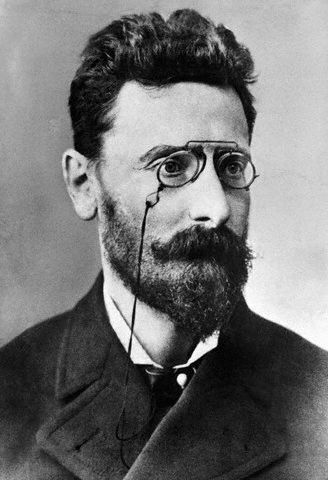 The last-minute savior of the project proved to be Joseph Pulitzer, the Hungarian-born publisher of one of New York City’s dailies, the New York World. Nothing pleased him more – or boosted circulation more – than a crusade in print against monopolies, corruption, and the misdeeds of the rich. Seeing the statue as a gift from the common people of France to the common people of America, he announced that what high-society fund raisers had failed to do in a decade, he and the readers of the World would accomplish in a matter of months. “The World is the people’s paper,” he declared, “and it now appeals to the people to come forward and raise this money.”
The last-minute savior of the project proved to be Joseph Pulitzer, the Hungarian-born publisher of one of New York City’s dailies, the New York World. Nothing pleased him more – or boosted circulation more – than a crusade in print against monopolies, corruption, and the misdeeds of the rich. Seeing the statue as a gift from the common people of France to the common people of America, he announced that what high-society fund raisers had failed to do in a decade, he and the readers of the World would accomplish in a matter of months. “The World is the people’s paper,” he declared, “and it now appeals to the people to come forward and raise this money.”Pulitzer’s journalistic instincts were sound: money poured in -- pennies, dimes, and quarters – and circulation soared. Organizers ordered work on the pedestal to resume, and when the crates with the statue arrived in New York harbor on June 17, 1885, the yet-to-be-assembled statue was greeted with the greatest excitement. On August 11 Pulitzer announced that the donations had reached the astonishing total of $100,000. When the assembled statue, reinforced by an interior support structure of iron, was dedicated by President Grover Cleveland and unveiled by Bartholdi on October 28, 1886, none of the speeches by dignitaries mentioned immigrants. But from then on, incoming vessels crammed with immigrants fleeing inequality and oppression in Europe began viewing the Lady as a symbol of the liberty they hoped to enjoy in America.
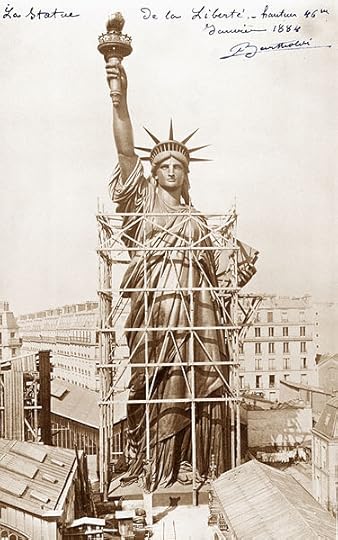 The assembled statue in Paris, 1884. It was then taken apart,
The assembled statue in Paris, 1884. It was then taken apart, shipped across the Atlantic, and reassembled here.
Viewing the statue from a distance, as most of us do, we may miss some significant details. The pedestal, a truncated pyramid, has classical touches, including Doric portals. But who looks at that? It's the statue on the pedestal that catches the eye. If the right hand holds aloft a torch that lights the world, the left hand clasps a tablet inscribed in Roman numerals with the date July 4, 1776. Invisible unless seen close up, at the statue’s feet lies a broken chain half hidden by her robe – a discreet allusion to emancipation. And those seven spikes radiating from her head? Rays from her crown, representing the sun, the seven seas, and the seven continents. Modeled on the Roman goddess Libertas, the Lady radiates classical gravity and dignity, and not the fury and violence of the French Revolution, as shown in Delacroix’s painting Liberty Leading the People (1830, another year of revolution), where the bare-breasted Liberty leads an armed mob over the bodies of the fallen -- just the kind of violence that prompted Tennyson, a good English conservative, to deplore "the red fool-fury of the Seine." Bartholdi and his friends believed in freedom and democracy, but not in revolution and violence. And his Lady has worn well, surviving the political partisanship that might have dethroned a more controversial figure. Many a time, returning on a late summer afternoon from a hike in the Staten Island Greenbelt, I have seen Americans and foreigners alike flock to one side of the ferry to view the statue and take the requisite photographs. Bartholdi’s Lady has indeed become a symbol of both the city and the nation and what, at their best, they stand for.
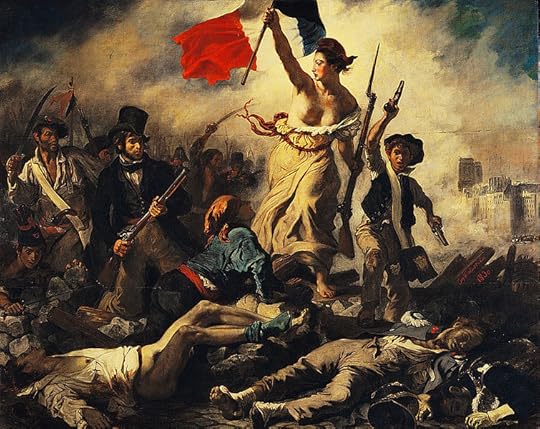 Delacroix's Liberty Leading the People (1830). Impressive, but not what Bartholdi had in mind.
Delacroix's Liberty Leading the People (1830). Impressive, but not what Bartholdi had in mind.Sadly, Emma Lazarus did not live to see the triumph of the statue and recognition of her sonnet, for she died of cancer in 1887. Americans who were not recent immigrants were slow in seeing the statue as welcoming immigrants to the land of freedom. Only in 1903 did they place a bronze tablet inside the entrance to the statue’s pedestal bearing her now-famous lines.
 At sunset, December 2002.
At sunset, December 2002.Geographer
(A footnote: Jealous little New Jersey, always resentful of the Empire State, has presumed to lay claim to Bedloe’s [now Liberty] Island and, by extension, to the Statue of Liberty, a claim that I, as a dedicated New Yorker and patriotic American, reject with scorn. Those incoming hordes of immigrants didn’t dream of New Jersey as their goal – did they even know it existed? No, they dreamed of New York City as the gateway to the land of liberty. And so, New Jersey, hands off our colossus! Send us your mosquitoes, if you must, and the stink of your marshes and oilfields, but leave our Lady alone.)
Source note: For information on Emma Lazarus and the building of the statue, I am especially indebted to Tyler Anbinder, City of Dreams: The 400-Year Epic History of Immigrant New York (Houghton Mifflin Harcourt, 2016), an impressive and masterful account of the role of immigrants in the history of New York City.
BROWDERBOOKS
All books are available online as indicated, or from the author.
No Place for Normal: New York / Stories from the Most Exciting City in the World (Mill City Press, 2015). Winner of the Tenth Annual National Indie Excellence Award for Regional Non-Fiction; first place in the Travel category of the 2015-2016 Reader Views Literary Awards; and Honorable Mention in the Culture category of the Eric Hoffer Book Awards for 2016. All about anything and everything New York: alcoholics, abortionists, greenmarkets, Occupy Wall Street, the Gay Pride Parade, my mugging in Central Park, peyote visions, and an artist who made art of a blackened human toe. In her Reader Views review, Sheri Hoyte called it "a delightful treasure chest full of short stories about New York City."
If you love the city (or hate it), this may be the book for you. An award winner, it sold well at BookCon 2017.
Available from Amazon and Barnes & Noble.

Bill Hope: His Story (Anaphora Literary Press, 2017), the second novel in the Metropolis series. New York City, 1870s: From his cell in the gloomy prison known as the Tombs, young Bill Hope spills out in a torrent of words the story of his career as a pickpocket and shoplifter; his brutal treatment at Sing Sing and escape from another prison in a coffin; his forays into brownstones and polite society; and his sojourn among the “loonies” in a madhouse, from which he emerges to face betrayal and death threats, and possible involvement in a murder. Driving him throughout is a fierce desire for better, a persistent and undying hope.
For readers who like historical fiction and a fast-moving story.

For six LibraryThing prepublication reviews of Bill Hope: His Story, go here and scroll down.
The Pleasuring of Men (Gival Press, 2011), the first novel in the Metropolis series, tells the story of a respectably raised young man who chooses to become a male prostitute in late 1860s New York and falls in love with his most difficult client.
What was the gay scene like in nineteenth-century New York? Gay romance, if you like, but no porn (I don't do porn). Women have read it and reviewed it. (The cover illustration doesn't hurt.)
For Goodreads reviews, go here. Likewise available from Amazon and Barnes & Noble.

Coming soon: The Waldorf Astoria and the End of an Era.
© 2017 Clifford Browder
Published on July 05, 2017 04:14
July 2, 2017
306. Martin Shkreli, the Bad Boy of Finance
BIG NEWS: I have a new book in the pipeline, to be announced in time. Meanwhile, for a sample of enhanced and shameless huckstering of my other books, see the BROWDERBOOKS section below. (I may do a post sometime on authors as whores, hawking their wares to the public.)
Visitors to this blog with long memories may recall post #214 of January 10, 2016, plus a follow-up in post #223 of March 27, 2016, on Martin Shkreli, a financial whiz kid who had just been arrested by the F.B.I. and arraigned in the Federal District Court in Brooklyn on securities fraud and wire fraud charges, for which he could get 20 years in prison. Mr. Shkreli was certainly something of a phenomenon, for he had spawned in quick succession a host of enterprises:
1. Elea Capital Management, a small hedge fund (2006)2. MSMB Capital Management, another hedge fund (2009), followed by yet another, MSMB Healthcare (2012)3. Retrophin, a biopharmaceutical company (2011)4. Turing Pharmaceuticals, another drug company (2015)5. KaloBios, yet another drug company (2015)
An impressive roster, one might think, until one became aware of these facts:
1. Under his management Elea lost tons of money in disastrous speculations.2. As head of MSMB Capital Management he allegedly lied to investors, which led to the federal charges against him.3. He evidently plundered Retrophin to pay off the MSMB investors, and then raised prices on certain drugs to astronomical levels, until ousted by the company’s board of directors.4. As CEO of Turing he raised the price of the 62-year-old drug Daraprim by 5,000 percent, thus incurring the wrath of many.5. As head of KaloBios he announced plans to hike the price of one of its drugs as well, until the company fired him and filed for bankruptcy.
What makes Mr. Shkreli interesting? At the time of his arrest he was all of 32 years old: a boyishly handsome young man with dark hair and an engaging – some might say infuriating – smile. Labeled a “morally bankrupt sociopath” for boosting the prices of drugs to celestial (or diabolical) heights, he continued to flash his smile, not just untroubled by the hostile brouhaha, but absolutely glorying in it.
 Mr. Shkreli testifying before the House Oversight Committee in February 2016.
Mr. Shkreli testifying before the House Oversight Committee in February 2016.Brooklyn-born and the child of immigrants, he might seem to embody the immigrant’s dream come true: already, in his tender years, he is worth millions, though just how many isn’t too clear. Also, a millennial to the core, when not engaged in financial hanky panky he spends hours tweeting on Twitter, and indulging in hour-long live streams on You Tube, proclaiming himself “the world’s most eligible bachelor,” a stupendous catch for some lucky girl … or girls. Photos confirm that he is young and good-looking, one of those guys whose one-day accumulation of beard makes them look even sexier. And his notoriety, he insists, adds to his appeal to women.
Mr. Shkreli intrigues me by virtue of his ability to survive disastrous failures and bounce back with a smile; his ability to find investors for yet another dubious venture; his obsessive vanity and endless self-indulgence; his true Brooklyn chutzpah. Truly, he is one of a kind. Like him or hate him, but it’s hard not to follow the latest twists and turns in his improbable career – attention that he welcomes and revels in. For more about this engaging rascal, I refer readers to my earlier post, in which I likened him to The Donald, then only a candidate and not our Twitterer in Chief. But now he reminds me of Roy Cohn, the attack-dog lawyer of post #137, who was also immune to criticism and even reveled in his notoriety, knowing that it would bring him clients. The two of them, being in so many ways my opposite, fascinate me.
In 2016, called before the House Oversight Committee at a hearing on drug prices, he invoked the Fifth Amendment to avoid testifying, then smirked through the hearing. Returning home, he tweeted: “Hard to accept that these imbeciles represent the people in our government.” Tact and reticence are not his thing.
So what’s with Mr. Shkreli now? He had dropped out of my purview for months, but now the self-styled bad boy of finance, age 34, has reappeared. The Times of June 23 features him in an article by Stephanie Clifford on the first page of the Business Day section, with a selection of his tweets:
· I am a god.· You’re a loser who doesn’t understand economics or business. Keep my name out of your mouth.· plz @god let me have sex with jewel
Lucky jewel, whoever she may be. Also, that tweet is the first indication I have received to date that Mr. Shkreli deeply needs anyone in his life but himself. Girls yes, but only if and when he can find time for them, and he boasts that the line is long. As for tweeting, it now appears that he has been banned from Twitter for harassing a journalist.
And the occasion of the Timesarticle? His appearance in court on June 19 for a hearing, prior to his forthcoming federal trial. A photo shows him striding purposefully courtward, a lock of dark hair hanging down fetchingly on his forehead, with a team of lawyers in close array. In court he was uncharacteristically subdued, following which he went home and – very characteristically – live-streamed himself on his computer, patting his cat, drinking Coca-Colas, and chatting live in another window while playing online chess. All this and more, with hardly a hint of his pending trial.
The trial is expected to last six weeks. “I’m so innocent,” he insists in a live stream, “that the jury, judge and the prosecution are gonna give me an apology.” His lawyer has asked for a reduction of his $5 million bail, stating that the defendant has no bank accounts, and no valuable assets other than his share in Turing, worth $30 to $50 million, which he is restricted from selling. But the prosecutor countered that Mr. Shkreli paid $40,000 to someone for solving a geometry proof, and offered $100,000 for information leading to the murderer of the Democratic National Committee staff member Seth Rich, as well as other gestures of largesse. The judge has yet to rule on the matter. Meanwhile it’s worth remembering that the Wunderkind is on trial for financial fraud, not for hoisting pharmaceutical prices skyward or being atrociously self-centered and enamored of risk and notoriety, offenses that may offend, but that are not indictable. I await his trial with the keenest interest.
And how does he fare with the younger set? If you glance at the online comments on a live stream of his about investing, you get quite a variety of answers, including some lively exchanges among the viewers:
· You should write a book about your life, investing, or both. I would totally buy it.· He might increase the price by 5000%. You’ll still buy it?· People hate on this guy but he’s smart as fuck he really started from the bottom.· Do some research dumb ass.· True American success story. Also hilarious troll.· Martin Shkreli is an adult in a world of children.· Im 14 but its never too early to learn about making money right?
Plus some other comments not fit to be repeated here (online, it’s no holds barred). Controversial though he is, Mr. Shkreli has made his mark, hence this post, my third on him and his shenanigans.
But it is not the younger set who will serve on his jury, and his notoriety does not endear him to those who may. When jury selection began at the Federal District Court in Brooklyn on Monday, June 26, 120 potential jurors were dismissed for various reasons, some of them having called him “a snake,” “the most hated man in America,” or “the face of corporate greed.” One said that his parents used the drug Daraprim, whose price Shkreli had raised from $13.50 to $750 a pill, and another said his kids were on some of the drugs involved. Fortunately, the necessary jurors were finally impaneled, so the trial could begin.
On Wednesday, June 28, the lawyers made their opening statements to the jury, and the contrast between the two statements could not have been more striking. Predictably, the prosecutor described Mr. Shkreli as a "con man" who falsified investor statements, backdated documents, misled investors about his record as a fund manager, and misstated how much money was in his funds: "lies on top of lies on top of lies." As he spoke, Mr. Shkreli rolled his eyes and made faces.
The defense attorney then described his client as "strange," shuffling around his office in bunny slippers with a stethoscope around his neck because he felt comfortable that way. Strange, but "brilliant beyond words," innocent of the charges, and bullied by Retrophin board members who questioned his sexuality. That board, he asserted, is "a bunch of thugs." As for the investors in Mr. Shkreli's funds, they are sophisticates with money to burn, high rollers, and "crybabies." Hearing this, Mr. Shkreli beamed.
(To be continued, as the trial proceeds.)
BROWDERBOOKS
All books are available online as indicated, or from the author.
No Place for Normal: New York / Stories from the Most Exciting City in the World (Mill City Press, 2015). Winner of the Tenth Annual National Indie Excellence Award for Regional Non-Fiction; first place in the Travel category of the 2015-2016 Reader Views Literary Awards; and Honorable Mention in the Culture category of the Eric Hoffer Book Awards for 2016. All about anything and everything New York: alcoholics, abortionists, greenmarkets, Occupy Wall Street, the Gay Pride Parade, my mugging in Central Park, peyote visions, and an artist who made art of a blackened human toe. In her Reader Views review, Sheri Hoyte called it "a delightful treasure chest full of short stories about New York City."
If you love the city (or hate it), this may be the book for you. An award winner, it sold well at BookCon 2017.
Available from Amazon and Barnes & Noble.

Bill Hope: His Story (Anaphora Literary Press, 2017), the second novel in the Metropolis series. New York City, 1870s: From his cell in the gloomy prison known as the Tombs, young Bill Hope spills out in a torrent of words the story of his career as a pickpocket and shoplifter; his brutal treatment at Sing Sing and escape from another prison in a coffin; his forays into brownstones and polite society; and his sojourn among the “loonies” in a madhouse, from which he emerges to face betrayal and death threats, and possible involvement in a murder. Driving him throughout is a fierce desire for better, a persistent and undying hope.
For readers who like historical fiction and a fast-moving story.

For six LibraryThing prepublication reviews of Bill Hope: His Story, go here and scroll down.
The Pleasuring of Men (Gival Press, 2011), the first novel in the Metropolis series, tells the story of a respectably raised young man who chooses to become a male prostitute in late 1860s New York and falls in love with his most difficult client.
What was the gay scene like in nineteenth-century New York? Gay romance, if you like, but no porn (I don't do porn). Women have read it and reviewed it. (The cover illustration doesn't hurt.)
For Goodreads reviews, go here. Likewise available from Amazon and Barnes & Noble.

Coming soon: In honor of the Fourth of July: Lady Liberty and How She Came to Be. After that, maybe the legendary Waldorf Astoria and what's happening to it now.
© 2017 Clifford Browder
Published on July 02, 2017 04:36
June 28, 2017
305. Swedish Midsummer and Gay Pride 2017
My quiet little West Village weekend began with a Swedish Midsummer celebration given by neighbors on Perry Street, just a block from my building on West 11th. I knew next to nothing about Swedish Midsummer celebrations, which include a maypole, and I didn’t know the hosts of the affair, but when I got an invitation stuck under the door in my vestibule, I thought it a gracious gesture on their part and sent an e-mail saying I would be glad to attend. I offered to bring a Magnolia cupcake, but the hostess, Yasmina, advised me by e-mail not to, since ten kids would be on hand, and only one cupcake might provoke a war. So at 3:30 p.m. on Saturday, June 24, I went without a cupcake, armed only with the best intentions and a touch of curiosity. I don’t have a drop of Swedish blood in me, and know not a word of the language other than"glögg," a hot spiced wine that I once imbibed at a party where I exchanged a New Year's kiss with a newly crowned and very blond Bride of Light. No matter, I was ready for a bit of adventure.
 The Swedish flag.
The Swedish flag.The host met me at the door, recognized my name from the e-mails, and led me through their ground floor apartment to a door in back that opened onto a garden area shared with all the buildings on Bleecker Street between West 11th and Perry. Adorning this huge open space was a ribbon-bedecked maypole topped with Swedish flags, while more than ten kids were running about, some of them wading barefoot in a little pool at the far end of the garden. My hostess Yasmina, crowned with a flowery wreath, now greeted me in turn, promised me a white wine, and introduced me to several other guests. I talked for a while with an older gentleman who said he was originally from Montreal. “Do you miss Canada?” I asked. “Yes,” he said, “it’s calmer, more laid back.” “And saner,” I suggested, having always thought of our neighbors to the north as being more reasonable and orderly than Americans, though perhaps just a little bit duller.
 Not my hostess, but the kind of wreath that she and several other women wore.
Not my hostess, but the kind of wreath that she and several other women wore.Calle Bonath
More guests appeared, and I talked with several. Having been told that one guest had come all the way from Bali, I approached an elegantly dressed young Asian woman, introduced myself, and asked if she was from Bali. “Oh no,” she answered in perfect American English, “I’m from Ohio.” I then identified myself as an immigrant from Illinois, and we found that, Midwesterners though we were, we shared a love of New York City, where you could find everything you wanted within walking distance, without the need of a car. And when I told others that I thought of Sweden as a country I wouldn’t mind living in, should I be granted another life, I was informed that Sweden had more to offer than universal health care and other such benefits – namely, tall blond women. Which, for another life, didn’t sound so bad.
 My next life?
My next life?Blondenaked
All the adults were now summoned to form a circle around a stash of bottles stuck in a heap of ice cubes to keep them appropriately cool. Once we had all been given a tiny plastic cup full of Schnapps, a lady wise in the ways of the Swedes sang something in Swedish, joined by several others, while I discreetly hummed along. Then, suddenly, everyone simultaneously lifted their little cup and drank the contents in one gulp – in other words, to use a very American but very un-Swedish term, we chugalugged it. This was my first experience of Swedish Schnapps, which my hostess by e-mail had assured me would be served. For me, “Schnapps” was a German word for almost any alcoholic drink, but in Swedish it apparently means something more specific. “Hey, that stuff has bite!” I immediately announced, and was greeted with knowing smiles. Indeed, there was fire in my throat.
If Schnapps was for the adults, the maypole was for the kids, who, I might add, were amazingly well behaved throughout: a good bit of running about, but so far as I could tell, no temper tantrums, jealousies, or fights. Now, guided by the Swedish lady, the kids formed a circle around the pole, each holding a ribbon attached to the top of the pole. Then they started walking around it, while their guide sang a song in Swedish, showing them how to hold their hands up to their ears and wiggle their fingers, then hold their hands behind their bottom and do the same, and then all jump together. Adults then joined the circle, performing the same rites, whose meaning totally escaped me. Later Yasmina explained to me that there were many silly songs in Sweden, and this one was about frogs: they have no ears (hence the gestures by the ears), and have no tails (hence the gestures behind), but they like to jump about (hence the collective jumps at the end). “That’s good,” I said. “We should all at times get just a bit silly. It keeps us from taking ourselves too seriously, and it’s healthy, we’ll all live longer.”
[image error] Dancing around a maypole in Sweden.
Our hosts now invited us inside to have a Swedish meal. Awaiting us on a counter were two kinds of salmon, some kind of white sauce to go with them, beets cut up into tiny cubes, potatoes cooked in some way that made them utterly delicious, a stiff sheet of bread from which each of us broke off a bit, and later, by way of desert, rolls that were also delicious. This was my first experience of Swedish food (minus a few encounters with Swedish meatballs), and I feasted greedily.
When, after two hours in Sweden, I took my leave, having responsibilities at home, the party was still going strong. Yasmina saw me to the door, insisted that I fulfill my promise to do a post for my blog about the party, and promised in return to invite me to the annual celebration again in a year. I went home in a gentle state of euphoria, nursing wondrous thoughts about Sweden and the Swedes, with fond memories of a celebration that was not only traditional, but also quiet, civilized, and sane. Which was my last experience that weekend of anything quiet, civilized, and sane.
Before chronicling the madness that followed, I’ll report that as a follow-up to the party I did a little online research and learned that the Midsummer celebration, which is really a summer solstice event marking the end of spring and the onset of summer, is celebrated throughout northern Europe. As for the maypole, it dates back to pagan times and was originally a phallic symbol, its penetration of the earth enhancing fertility and growth. Ah, those pagans, so naughtily obsessed with sex! But the maypole dancing I had just witnessed was innocent in the extreme, a charming festival for kids.
* * * * * * Sunday, June 25, began routinely enough, with my housebound partner Bob and I sipping white wine and nibbling a sharp cheddar cheese. Then, as usual, leaving him with our home-care aide, I set out for my weekly lunch in a restaurant. Having witnessed the joyous mayhem of the Gay Pride Parade a number of times in the past, I felt no need to witness it again, and wanted only to avoid the brouhaha and lunch quietly at a safe remove. Since our building at the corner of West 11thand Bleecker would be in the hurricane zone, with the parade almost reaching the Hudson River a few blocks away, and the parade aftermath spilling over into the whole West Village near the river, I knew to head away from the parade toward a Chinese restaurant on Greenwich Avenue near Sixth, well away from the parade route along Fifth Avenue. There, I thought, I could dine quietly and then cross Greenwich to the Jefferson Market Library, my branch, where I could return one book and get another. With this sane and rational plan in mind, I set out about 2:30 p.m.
The stack of police barriers piled up against the Magnolia Bakery should have tipped me off, not to mention the frequent sound of helicopters zooming overhead. But we all have our illusions, and mine were soon deflated. Just walking down West 11th toward West 4th Street (yes, they do intersect; such is the Village), I found this usually tranquil residential street surprisingly busy. And when I turned right onto West 4th, heading toward West 10th and, just beyond it, Seventh Avenue, I found the crowds getting thicker and spilling over into the street, where no traffic presumed to intrude. And the closer I got to Seventh Avenue, the thicker were those crowds. Rainbow flags and crazy T-shirt sayings multiplied, and a familiar wildness set in. Seeing three girls with bright-colored leis sitting on a doorstep, I stopped, gestured toward their leis, said, “I love it!” and reaped a trio of smiles.
 See-ming Lee
See-ming LeeFrom then on, it got crazier and crazier, and the noise of drumbeats in the offing got louder. There were rainbow flags galore, and rainbow T-shirts, hats, ties, garlands, capes, and shorts. And everywhere, T-shirts flaunted mottos and quips:
· LOVE · ROUGH TRADE· TOM / BOY· SANCTUARY FOR FAMILIES· BEAST· BEAUTY (marching beside BEAST)· LOVE ALWAYS WINS· CONTINUING THE POLITICAL REVOLUTION (on an older man)· I LIKE GIRLS (on a woman, of course)· SOUNDS GAY / I’M IN· HAVE AN EPIC DAY· NOBODY EVEN KNOWS I’M A LESBIAN (on a presumably straight young man)
It was a festival of youth, but lots of the rainbow flag wavers looked hetero and must have been playing queer for the day, just as the non-Irish go green on Saint Patrick’s Day. Wild colors were the rule, though mixed in with the celebrants were a few strays who looked like they didn’t know what they’d got into and desperately wanted out. There were bearded men with fans, leather guys, garlanded young men, lesbians of every stripe and hue, and one seemingly unperturbed Orthodox Jew who was most definitely not seeking out the parade.
Though the parade was coming down Fifth Avenue, as I approached Seventh on West 4thStreet, I found a jam-up of people ahead of me, and when I turned left on West 10th Street and headed toward Greenwich Avenue and Sixth, the police were heavily on hand and guiding pedestrians into separate walkways for those coming and going, so as to avoid a crush of people and the possibility of panic. I was puzzled to see a long line of people extending well out into 10th Street, and then grasped it: they were in line for the porto-potties.
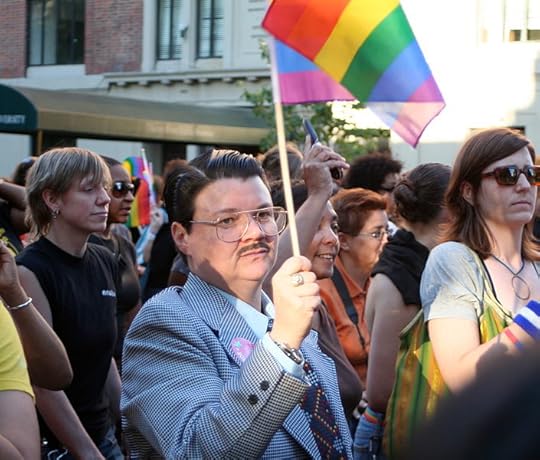 Boss Tweed
Boss TweedParked police cars and sanitation trucks had blocked off Greenwich Avenue, and to reach my restaurant on Greenwich I had to ask New York’s Finest for permission to get through their barriers. Up ahead on Sixth Avenue, which I thought would be free of the parade, I could see rainbow banners and Old Glory marching by, to the steady beat of drums. As for the Chinese restaurant that I thought would be a quiet sanctuary removed from the turbulence of the day, it was packed like I had never seen it packed, with a steady murmur that rose at times to a roar.
Luckily I got a seat in front by a window, where I could see people streaming back from Sixth Avenue, where they had seen whatever was there to be seen. Seated near me in the restaurant was a group of young men and women, one of the women, her hair half curly blond, half dark, with two stripes under each eye. And at the table right next to me was a young African American male in the skimpiest striped bikini, garlanded, with a rainbow flag stuck in his backpack, and his nose in his mobile device.
When I left the restaurant and headed across Greenwich on West 10th toward the library, I once again found myself guided into an eastward flowing crowd, and to get to the library itself I had to ask the guardians of order to once again open their barriers. “Come out the same way,” the cop instructed me, as he moved a barrier just enough to let me through. The library itself, though open, seemed deserted, but on the second floor, where I returned a book and took out another, a few quiet souls sat docilely at tables, their nose in a book, newspaper, or computer, seemingly immune to the frenzy outside. Calm should of course prevail in a library, but this calm was the calm of a tomb.
Leaving, I plunged back into the frenzy, heard police sirens in the distance, saw parked police cars flashing lights, and a Fire Department ambulance honking its way down West 10th, parting the crowd as it slowly advanced. More flags, more crazy T-shirt messages, more lines for porto-potties, more glitz and glitter, and when I flashed a sign of solidarity at two gay guys in flowery attire, they answered with smiles and a wish of “Happy Pride Day!” The farther I went down West 4th, the quieter it got, and I even saw a vehicle or two presume to crawl down the street. As for my street, West 11th, it was now so calm as to seem, for the day, unnatural. So ended my experience of Gay Pride 2017, or so I thought. Need I say that I was joyously exhausted and in desperate need of a nap.
Some parties never seem to end. When I went to bed that night, I still heard helicopters zooming overhead and, for a while, the BOOM BOOM BOOM of fireworks. And as these noises finally faded, a sudden revelation flashed in my sleep-hungry brain: coming down Fifth Avenue and then west on 8th Street, the parade had made a short zig to the right, going up Sixth Avenue to access Christopher Street, which it then followed west toward the river. As I walked toward Greenwich Avenue on West 10th Street, I was just one short block away from Christopher, which parallels West 10th. And what is there on Christopher between Sixth and Seventh Avenues? That holy of gay holies, the Stonewall Inn, where, years ago, all this madness began. Of course Christopher between the two avenues had to be the wildest, craziest, most congested and crowd-controlled stretch of the parade. Far from avoiding the brouhaha, my route had taken me right into the eye of the storm. What was going on at the end of Greenwich Avenue, when I entered the Chinese restaurant, was indeed the parade, doing its little zig to get from West 8th Street to enter Christopher. Which explains the heavy police presence, the blockaded streets, the not-so-distant drumbeats, even the porto-potties and the scrupulous control of the crowds. I have great respect for the Gay Pride Parade and all it represents, but can gladly wait another year before its joyous mayhem disrupts my life again.
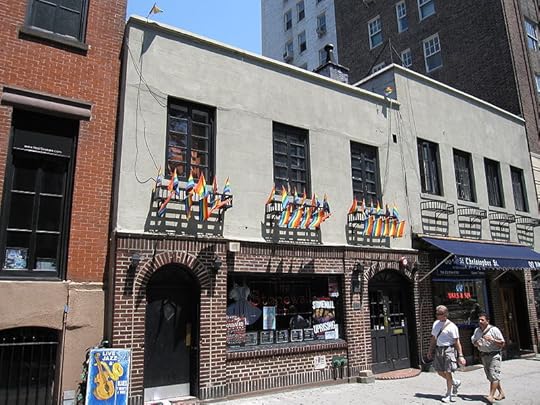 Stonewall Inn on a quieter day.
Stonewall Inn on a quieter day.Gryffindor
BROWDERBOOKS
No Place for Normal: New York / Stories from the Most Exciting City in the World (Mill City Press, 2015). Winner of the Tenth Annual National Indie Excellence Award for Regional Non-Fiction; first place in the Travel category of the 2015-2016 Reader Views Literary Awards; and Honorable Mention in the Culture category of the Eric Hoffer Book Awards for 2016. All about anything and everything New York: alcoholics, abortionists, greenmarkets, Occupy Wall Street, the Gay Pride Parade, my mugging in Central Park, peyote visions, and an artist who made art of a blackened human toe. In her Reader Views review, Sheri Hoyte called it "a delightful treasure chest full of short stories about New York City." If you love the city (or hate it), this may be the book for you. Available from Amazon and Barnes & Noble.

Bill Hope: His Story (Anaphora Literary Press, 2017), the second novel in the Metropolis series. New York City, 1870s: From his cell in the gloomy prison known as the Tombs, young Bill Hope spills out in a torrent of words the story of his career as a pickpocket and shoplifter; his brutal treatment at Sing Sing and escape from another prison in a coffin; his forays into brownstones and polite society; and his sojourn among the “loonies” in a madhouse, from which he emerges to face betrayal and death threats, and possible involvement in a murder. Driving him throughout is a fierce desire for better, a persistent and undying hope.

For six LibraryThing prepublication reviews of Bill Hope: His Story, go here and scroll down.
The Pleasuring of Men (Gival Press, 2011), the first novel in the Metropolis series, tells the story of a young male prostitute in the late 1860s in New York who falls in love with his most difficult client. Gay romance, if you like, but women have read it and reviewed it. For Goodreads reviews, go here. Likewise available from Amazon and Barnes & Noble.

Coming soon: Martin Shkreli, the Bad Boy of Finance
© 2017 Clifford Browder
Published on June 28, 2017 04:22
June 25, 2017
304. Americans Are Ghouls
MUMMIES LIKE YOU’VE NEVER SEEN MUMMIES
WHAT NEW TECHNOLOGY REVEALS
INTERACT WITH THE LONG BURIED DEAD
THE SECRETS OF AMERICA REVEALED
THE PRESIDENT, THE HOLLYWOOD STAR
THE ATHLETE, THE SCIENTIST
SEE THEIR FALSE TEETH AND HAIR
THEIR CAVITIES, THEIR FACE LIFTS
An exciting new exhibit at the American Museum for Historical Archaeology lets visitors probe the deepest mysteries of mummies of exalted personages of 21st-century America, when mummification of dignitaries became a new fad that swept the nation. Modern science by noninvasive means is able to penetrate the elaborate coffins and sarcophagi in which these personages have lain for centuries, helping us to grasp the baffling civilization then flourishing in North America. SEE the remarkably preserved remains of the President, the Hollywood Star, the Athlete, the Scientist, and others of that long-vanished and enigmatic civilization. With the help of interactive devices penetrate the coffins and sarcophagi to view the bodies wrapped in ghostly linen, then unwrap them and view the physical remains themselves, observe and even touch their face, their hair, their arms crossed devoutly on their chest, even their genitals.
YOU WILL BE TRANSFORMED
Suitable for kindergarten and up. Reservations required; members free.
All right, as of this date there is no such exhibition and no such museum. This little fantasy was inspired by a full-page add for the current exhibition “Mummies” at the American Museum of Natural History, which most definitely does exist here in Manhattan at 79th Street and Central Park West, a vast institution with marvels to display. The museum’s website entices prospective visitors with a “teaser” of a video entitled “Unwrap a Mummy Interactive.” If you click on it, you will see a skeleton with arms crossed on its chest, then a painted Egyptian sarcophagus, then a wrapped body with a cutaway showing its innards: presumably, an appetizer to whet your hunger for the feast that follows at the museum. All of which, to my unscientific mind, seems just a little sick.
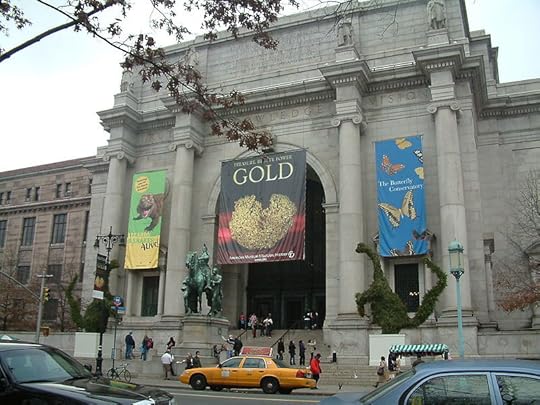 Here, at least, they're featuring gold. That I can take.Javier Carbajal
Here, at least, they're featuring gold. That I can take.Javier CarbajalIs my title exaggerated? Are Americans ghouls, because of our presumed interest in mummies? First of all, what is a ghoul?
Definition of Ghoul by Merriam-Webster
Definition of ghoul. 1 : a legendary evil being that robs graves and feeds on corpses. 2 : one suggestive of a ghoul; especially : one who shows morbid interest in things considered shocking or repulsive.
I suggest that unwrapping the mummified dead of an ancient civilization approaches ghoulishness; if the shoe fits, put it on.
The mummy on display in the video was, after all, a human being who was buried with all due honors by a civilization flourishing a few millennia ago, in hopes that he/she would live again in an afterlife. What neither the deceased nor those preserving the deceased could imagine was that, centuries hence, the mummified remains would be removed from the tomb and transported across an ocean to be exhibited in a museum in another culture whose allegedly scientific curiosity precluded any reverence beyond a scrupulous desire to preserve the mummy so it could be studied by specialists and then exhibited to the public.
Photographs of the exhibited mummies are credited to the Field Museum in Chicago, which, using noninvasive CT scans, developed this exhibit some years back, inviting viewers to “navigate into a sarcophagus, unwrap the outer wrappings, and explore the interior. You may think that you’ve seen mummies before, but you’ve never seen mummies like this.” The Field website included comments by visitors, most of whom anticipated the show with relish, but the comment that caught my attention said simply, “Bury the dead, you sick people.” The American Museum of Natural History’s teaser is a bit less lurid than the Field’s, but what it offers is identical, with its smaller follow-up ads inviting viewers to “unwrap the secrets of mummies.”
Since I grew up in Evanston, a suburb of Chicago, the Field Museum loomed large in my childhood. I was drawn to it almost obsessively by the dinosaur exhibits and, appropriately housed in a basement chamber that could (with imagination) be likened to a tomb, a display of Egyptian mummies. Far from being in any way unwrapped, the mummies remained in their elegant painted sarcophagi, which inspired fantasies of a long vanished and mysterious civilization. Later, when I would see photographs in books showing mummies that had indeed been unwrapped, I found the eerily preserved, or half preserved, remains grotesque.
 The daughter of a pharaoh. Does this transform you?
The daughter of a pharaoh. Does this transform you?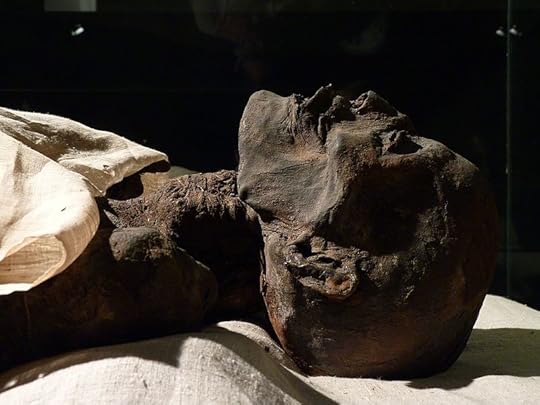 Or this? The Pharaoh Ramses I.Alyssa Bivins
Or this? The Pharaoh Ramses I.Alyssa BivinsWhat we do today in the name of science isn’t simply, at times, grotesque; it can become criminal. The best example I know of is the Tuskegee Syphilis Experiment, conducted by the U.S. Public Health Service from 1932 to 1972 at Tuskegee University, a black university in Alabama. Some 600 impoverished African American sharecroppers were recruited for the study with the offer of free medical care, meals, and burial insurance. Told they were being treated for “bad blood,” they were in fact being studied over time for the natural progression of untreated syphilis, with which some two-thirds of them were infected. These men were human guinea pigs and the experiment continued even after penicillin proved effective in treating the disease, ending only when exposed by a whistleblower in 1972. By then, 28 of the men had died of syphilis, and 100 of related complications. Today, even though we are often horrified by what the Middle Ages did in the name of religion, we often ignore equally monstrous deeds committed in the name of science.
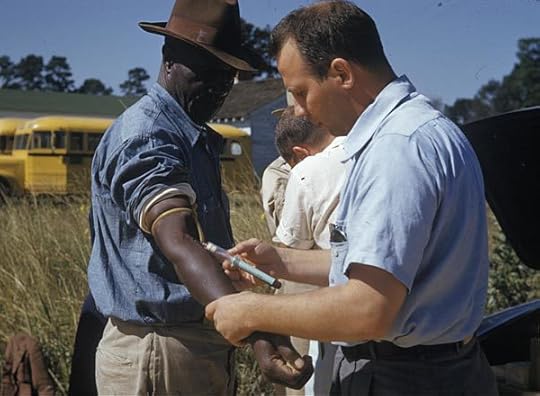 Here we see it: a white staffer injecting a black sharecropper, all in the name of science.
Here we see it: a white staffer injecting a black sharecropper, all in the name of science.What does this digression on the Tuskegee experiment have to do with mummies? It simply reinforces the awareness that, in the name of science, we are often blind to the ethical aspects of what we do. It’s okay to unwrap mummies and display them to the public; respect for the dead – in this case, the dead of an ancient civilization that long preceded us -- is deemed irrelevant. How future civilizations will look back at our own and judge it, I dare not contemplate. But I don’t anticipate visiting the mummies at the American Museum of Natural History, though I’m sure that hordes are flocking there already.
Our attitude toward mummies relates to our ambivalent attitude toward the dead, which I discuss at greater length in my award-winning work of nonfiction, No Place for Normal: New York / Stories from the Most Exciting City in the World (see below). This selection of posts from this blog discusses “spooks and ghouls” in one chapter, and resurrectionists (grave robbers), funerals, and related horrors in another. Halloween, the Mexican Day of the dead and its grotesque Grande Dame of Death, and the Doctors’ Riot of 1788 get a good working over, as well as body snatching (it still happens), including a lurid 1846 trial, American funeral customs and, to be sure, mummies. All of which makes for a tasty read.
BROWDERBOOKS: No Place for Normal: New York / Stories from the Most Exciting City in the World (Mill City Press, 2015). Winner of the Tenth Annual National Indie Excellence Award for Regional Non-Fiction; first place in the Travel category of the 2015-2016 Reader Views Literary Awards; and Honorable Mention in the Culture category of the Eric Hoffer Book Awards for 2016. All about anything and everything New York: alcoholics, abortionists, greenmarkets, Occupy Wall Street, the Gay Pride Parade, my mugging in Central Park, peyote visions, and an artist who made art of a blackened human toe. In her Reader Views review, Sheri Hoyte called it "a delightful treasure chest full of short stories about New York City." If you love the city (or hate it), this may be the book for you. Available from Amazon and Barnes & Noble.

Bill Hope: His Story(Anaphora Literary Press, 2017), the second novel in the Metropolis series. New York City, 1870s: From his cell in the gloomy prison known as the Tombs, young Bill Hope spills out in a torrent of words the story of his career as a pickpocket and shoplifter; his brutal treatment at Sing Sing and escape from another prison in a coffin; his forays into brownstones and polite society; and his sojourn among the “loonies” in a madhouse, from which he emerges to face betrayal and death threats, and possible involvement in a murder. Driving him throughout is a fierce desire for better, a persistent and undying hope.

For six LibraryThing prepublication reviews of Bill Hope: His Story, go here and scroll down.
The Pleasuring of Men (Gival Press, 2011), the first novel in the Metropolis series, tells the story of a young male prostitute in the late 1860s in New York who falls in love with his most difficult client. Gay romance, if you like, but women have read it and reviewed it. For Goodreads reviews, go here. Likewise available from Amazon and Barnes & Noble.

Coming soon: Martin Shkreli, financial whiz kid or fraudster? The boy wonder appears at last in court for trial. If his name doesn't ring a bell, it will. He's a master at ringing bells.
© 2017 Clifford Browder
Published on June 25, 2017 04:36
June 17, 2017
303. BookCon, Where Booky People Try to Geek Out
The last post told of the preparations by my young assistant Silas and myself as first-time exhibitors for BookCon 2017, the last two days of the biggest book event in the hemisphere, when the book trade, having networked for two days at BookExpo, invites the public in. Our booth was in the somewhat remote BookCon section of the show floor, reserved for small fry -- indie authors and small presses -- who chose not to rub shins with the biggies at BookExpo. The post ended when the gates at the Javits Convention Center swung wide open at exactly 10 a.m. on Saturday, June 3, and the first attendees poured in, some of them rushing in our direction.
Day 1 at the Javits
It began as a trickle of visitors who rushed right past us and the other booths selling books to buy postcards and other non-book items at the Strand Bookstore booth next to ours, and at Book Beau across the aisle. Then, by mid-morning, the trickle had become a steady flow, and people began noticing the other booths as well. Besides the anticipated hordes of female millennials, some of them in very short jeans or jeans with holes in the knees, there were moms with kids in strollers, people in motorized wheelchairs, black women with buns atop their head, young guys in skinny jeans, bored older males accompanying enthusiastic women, one woman in a burka with only her eyes visible, and clusters of girls in head scarves who giggled and darted about like other girls their age. Many had totes with lettering: I READ YA, ROGUE BOOK NERD, GET LOST IN THE STACKS.
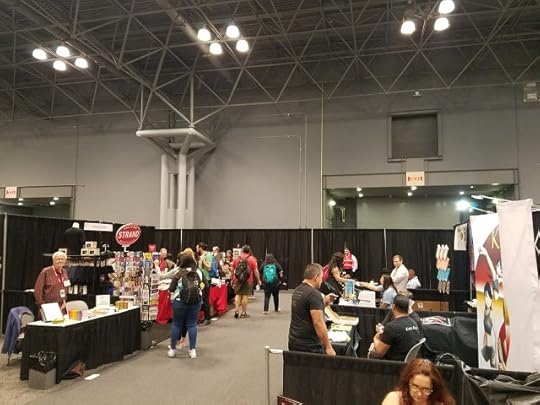 Our aisle at a quiet moment, with me on the left.
Our aisle at a quiet moment, with me on the left.As our aisle filled up, everyone's gimmicks went into full swing. I flashed my silly signs, reaped smiles; across the aisle author Jill Hynes offered free bookmarks to anyone within reach; another booth had on its counter a little gizmo that flashed lights; and the Kirin Rise Studios booth opposite us, manned by two husky males in black T-shirts, had some sort of whirligig that drew visitors while emitting a soft clickety clickety clickety.
Among the attendees, special effects abounded. Some wore unicorn horns on their forehead, or crowns or flowery headbands, or what looked like sprouting mouse ears, all of them probably giveaways from booths already visited. Young women strolled by in fancy long dresses like belles out of Gone with the Wind. Another woman sported a white parasol that looked like it was covered with mothballs, and yet another wore a weird yellow-and-blue cloth or fake-fur helmet that clasped her head on either side, a headdress that my helper Silas identified as a “spirit hat.” Both men and women of all ages appeared with curlicues of black face paint on one side of their forehead, an adornment administered by another booth previously visited. One tall young woman so adorned wore a long black dress and a white face mask that made her look absolutely spectral. But if some attendees were obviously onstage, others hurried by with a determined look on their face, bound for who knows where, while many lingered and browsed.
 No, I'm not sticking my tongue out; it just looks that way. Note my
No, I'm not sticking my tongue out; it just looks that way. Note my new motto: GEEZERS ROCK. And the little card pinned to my shirt:
NORMAL? NOT ME. I'M A NEW YORKER.
This parade went on past our booth for an hour, without our making a single sale. Then, as if out of nowhere, buyers began to appear. The first was an Asian American mother with a school-age son -- the last person I expected as a buyer – who bought No Place for Normal: New York, my stories about the city, probably in hopes of helping her boy with his English. At intervals – sometimes annoyingly long intervals – others followed. An older woman came and perused our books. “Where are you from?” I asked. “Can’t you tell?” she said with a thick Southern accent. “Ah’m from Alabama.” I welcomed her, delighted to have an out-of-state visitor, and she explained that her daughter – to her amazement – was obsessed with gay male coming-out stories. “Are you gay?” she asked bluntly, and I said that I was, hoping she might buy my gay-themed novel The Pleasuring of Men. But no, she wandered quietly off, perhaps not attuned to the diversity of New York. (Should I have asked her if she was heterosexual? Probably, but gentility prevailed.) Then my spirits rose again when a professor from Rhode Island appeared and, heeding our “Buy two, get one free” offer, gladly took all three books.
The strangest encounter of the day was a fiftyish woman who appeared and volunteered an account, with wild gestures, of her earlier years in the city. She had come in the 1980s as a young woman hoping for a glorious jo, stayed at the legendary Chelsea Hotel (see post #299), and when no glorious job appeared, spent the next ten years as a prostitute working with a pimp. “Wow!” I said. “You’ve got a story right there.” “I’m trying to write it,” she said, “but I’m stuck. And there’ll be a sequel, too: my life in the 1990s as a white girl in Harlem.” “That’s another story,” I said. “It is, but I’m stuck on the first one.” She then drifted off, and I had a hunch that those stories would never get written.
The three kinds of buyers
By the end of the day I had buyers classified as Impulse Buyers, Cautious Buyers, and Vanishing Buyers. Impulse Buyers came, took a quick look at the books, grabbed one, glanced at the blurb, thumbed through the pages a moment, and (God bless them) bought the book. Cautious Buyers, more numerous, looked at the cover, read the blurb on the back, looked through the pages, read the blurb again, looked again through the pages. By now our hopes were high. Some then wandered off, while others bought. Vanishing Buyers came, looked at the books with seeming interest, pondered, then announced, “I’ll be back,” or “I’ll bring my mom,” or “I’ll bring my friends,” or “I’m going to an ATM, back soon.” “We’ll never see them again,” said Silas, who had experience selling software. To reinforce his view, he told how he had once gone to buy a honeycomb from a local farmer at the Union Square Greenmarket. Finding he was short of cash, he told the farmer he’d go to an ATM, then return. When he did indeed return to buy the honey, the people at the stand were amazed, explaining that once people leave, they almost never come back. Usually Silas was right: when they’re gone, they’re gone; no sale. Some probably meant to return, but got distracted by other booths, other events. And some, having spent some time at the booth and raised our hopes, probably were embarrassed not to buy a book, therefore exited with a promise to return. But there were two exceptions, both on the Sunday following. An older man, probably gay and himself an author, returned as promised with his publisher, who had a booth nearby; taking us up on “Buy two, get one free," he scooped up all three books. And a woman who said she needed to get money from an ATM returned minutes later and likewise took all three books.
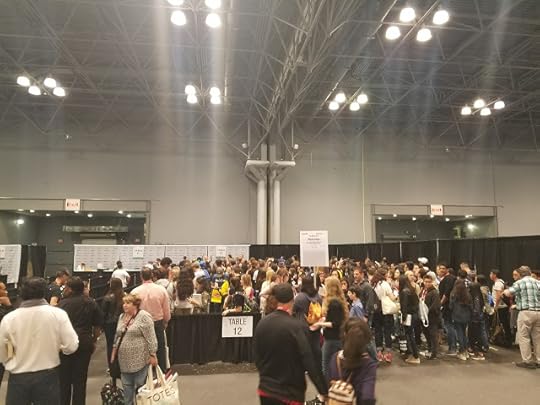 A busy BookCon scene.
A busy BookCon scene.Day 1: Taking stock
So what did I know by the end of Saturday, June 3? I had sold 15 books, hoped to sell as many more, to reach the minimally acceptable number of 30. And I had reaped a number of insights:
Female millennials aren’t interested in my books. No surprise.
People want things. Postcards, magnets, totes – something they can hold and show to others: souvenirs.
Buyers want the author's signature. They often asked me timidly, almost apologetically, if I would sign the copy they were buying, and were deeply grateful when I did.
The crowd effect. If one person comes to your stand, it may attract another, then another; a stand with no visitors attracts no one. (A thought for the future: bribe your friends to come and pretend to buy books.)
Gimmicks don’t sell books. Silly signs and banners and free bookmarks and whirligigs get attention, but only books sell books: the cover, the blurb, the content, plus a few cogent remarks from the author, if desired by the buyer and appropriate.
No claustrophobia. The Javits is vast; no matter how great the crowds, it never felt crowded.
Since I obviously wasn’t going to achieve my goal of 40 or more sales, alas, prudence dictated that I take home 10 books, so as to ease the final take-home load Sunday night. But Silas and I vowed from then on to scan the attendees' badges and get contact info; preoccupied with other matters, we’d forgotten to do this consistently.
Day 2 at the Javits
In many ways a repeat of Day 1, but with fewer attendees. Once again, with our table arranged most fetchingly and lots of candy heaped in the bowl, we waited for the first buyer … and waited and waited. Then, after 12 noon and once again out of nowhere, came a dynamic math and science teacher from Colorado Springs who wanted to orient her students toward literature as well; to that end, after giving it a good look, she bought Bill Hope, obviously not put off my the narrator’s torrent of words and his faulty grammar. She asked me to sign it, so I did, wishing her class a good read.
After that, others came as well. Two women from West Virginia, one now a South Carolina resident, were drawn to the New York stories; I thought they would share a copy, but no, each bought one for herself. With them and many who followed, I noticed that the book that got immediate attention was indeed the New York stories, because the cover had bright colors and the magic words “New York.”

Unique was the visit of Sweet Young Thing, who looked at my books, took to one of them, and asked if she could have it. “Of course,” I said, “for fifteen dollars.” A look of surprise and dismay. “It’s not free?” “No, miss. But it’s only fifteen dollars.” “Oh.” Crestfallen, Sweet Young Thing wandered off, leaving me with a twinge of
guilt at having destroyed her innocence. The big publishers often scheduled book giveaways at a certain time, and she had probably taken full advantage, thus fostering the illusion that all the books were free.
Whenever there was a flock of attendees close at hand, I flashed my silly signs:
BOOKS ARE SEXYBE WICKED: READ BOOKSEMBRACE THE MADNESSYOU READ? I LOVE YOUYOU'RE AWESOME / so am I
Usually they brought smiles in passing, and some people lingered to see the whole series. But one older woman came over and asked, "Why are books sexy?"
"Because they're fun," I said.
She looked unconvinced, so I went through the whole series of signs.
"That one is better," she remarked and then, a sign or two later, "Ah, that one I like." Having settled the matter in her mind, she walked off.
Some of our neighbors continued to puzzle us. The booth promoting TRADE SECRET TRILOGY / 13 CUTS had few visitors; we still didn't know what they were up to. And for some reason the two husky men in black T-shirts manning the Kirin Rise Studios booth across from us had put away their crowd-drawing whirligig and sat in their unvisited booth hour after hour, seemingly unperturbed.
Meanwhile much was happening around us, both close by and at a distance. Every so often we would hear a great muffled roar from far away, probably a throng of excited fans responding to some event with a celebrity author. But whenever music was played, it was barely audible where we were, so I had no opportunity to display my sign GEEZERS ROCK. And when I kept seeing a long line of attendees stretching out into a hall nearby, including many older women and one with a cane, I finally went to investigate and discovered that they were waiting for a precious minute or two with a popular author of romance who was signing their books. I didn't envy that author; all those signings must have left her fingers cramped.
Quick trips to the men’s room let me see young people sprawled in groups on the carpet, many of them with their nose in a tablet or a smart phone. And if some booths were besieged by attendees, there were others, even big ones, where a lone exhibitor waited in vain for visitors, so sad a scene that I almost went over to one or two of them just to say hello and give the exhibitor a moment of company. But my own booth beckoned, so I resisted this generous impulse. Some of those near-deserted booths may have been there primarily for BookExpo, with BookCon and its hordes a sequel of slight importance.

At other quiet moments I said hello to fellow exhibitors whom I had already been in touch with by e-mail. In the same aisle with me was Jill Hynes of Staten Island, displaying copies of her debut novel, I’ve Been Running for Miles … and Found Myself, whose title can only be fully grasped once you’ve read a good part of it. Piper Evans, the protagonist, is indeed a runner, but the Miles she is running for, or rather after, is an aging rock star whom she has a crush on and pursues relentlessly, and often futilely, from concert to concert. I have read the book and reviewed it on Goodreads, and can affirm that the real point of it becomes clear only at the end, when Piper takes stock of her obsession and achieves a resolution. It is all about true maturity and self-knowledge, something the young women flooding into BookCon could well come to terms with, though such awareness probably ripens only with time. The “hook” for readers, as Jill explained to us during a visit to our booth, is the protagonist’s being a single mother, which indeed hooked more than one reader. Even for those who, like myself, have little knowledge of, or interest in, the rock concert scene, the book is an excellent read.
In the next aisle over from ours was the booth of novelist David V. Mammina, a dark fantasy author from Long Island who proclaims himself “self-published and proud" -- a statement that I relish, having self-published one book myself. I haven’t read his novels, but their testing the boundaries between fantasy and horror, while also featuring plot and character development, should appeal to the young people flocking to BookCon. His website (mamminabooks.com) is ingeniously organized. It asks which genre you prefer – sci-fi, mystery/crime, horror, or young adult – then lets you state the length, setting, kind of protagonist, and other features that you prefer; finally, with all this in mind, it presents an appropriate title. If these genres appeal to you, you can’t do better than search out a title on David Mammina’s website. David was very helpful in giving me tips for successful exhibiting at BookCon, and told me that, having tried other venues, he had settled on BookCon because its attendees really like to read. He is a prime example of the truly independent author who bypasses the gatekeepers -- the agents and acquisition editors who erect barriers for so many new authors. Yet he assured me that, even now with all his experience, he's still learning.
In the booth right next to me, on the opposite side from the Strand, was Janelle Gabay, who lives with her husband and three children in Florida and exhibited for the first time at Chicago in 2016. She has authored two self-published books of fantasy science fiction where mortals and immortals mix -- thriller fiction that should appeal to the young women flocking to BookCon. First Born (2016) and its sequel, First Awakened (2017), will be followed by a third novel so as to create a trilogy. Janelle says that driving long distances inspires her; her office is her car, with voice dictation a must. She is another great example of an author who bypasses the gatekeepers to get her books published and into the hands of readers, and all this while raising a family. World, take note: Indie authors make things happen.
Day 2: Taking stock
So where was I at, after two days of this madness? Exhausted. As the closing hour of 5 p.m. on Sunday approached, Silas and I with our last grains of energy desperately begged people to feast on our candy, so we wouldn't have to tote it home with us. And once we packed up all the books and other stuff in the booth, took a taxi to my West Village building, and got everything up the four flights of stairs, we were both in a state of near collapse. Silas then went home, fell into bed, and slept eleven hours straight, which he had never done before in his life. I got what sleep I could, but it was several days before I could get the experience out of my mind enough to have a full night’s sleep. On Monday, the first day after the close, I was so tired that every time I tried to count the books that I had left, I got a different total; frustrated, I finally started giggling and couldn’t stop. BookCon is not easy on exhibitors. Vast and intense, how could it be?
Yes, we were worn out, but at least we didn't have to go back for the big Monday move-out, when all the vast carpeting is rolled up, empty cartons are returned to exhibitors to be used again, and the super-glitzy stands of the big publishers are dismantled and their books and other stuff carted of by forklifts to the loading docks nearby -- an epic spectacle that I had once hoped to view but now was happy to forgo.
The numbers game
I had taken 20 copies of Pleasuring and 20 of the New York stories to the show, and 40 of Bill Hope. I had sold 15 books the first day and 11 the second day, for a total of only 26, four short of the minimally acceptable total of 30. Under any other circumstances, selling 26 books in two days would vault an indie author to pinnacles of bliss. But this was BookCon, the once-a-year blockbuster event drawing multitudes of buyers, and I had hoped for more. Was my adventure, then, a waste of time? Not at all, for I had learned a lot. Who were my readers? Of all three books -- to my vast surprise -- older women. Some older men as well, but above all, older women, meaning women older than millennials. And where else could I have connected with a dynamic schoolteacher from Colorado, or two ladies from West Virginia, or all the others who bought my books?
Which book did best? I was offering three: The Pleasuring of Men, a historical novel about a young male prostitute in 1860s New York that could be labeled gay romance; No Place for Normal: New York, stories celebrating the weird and wonderful craziness of New York City; and Bill Hope: His Story, a historical novel in which a young pickpocket in 1870s New York spills out in a torrent of words his life in and out of prison. According to my less-than-perfect accounting, my sales were as follows:
5 Pleasuring, 7 Bill Hope, and 14 No Place for Normal: New York. So the self-published New York stories did best! Yet to my and Silas's surprise, several women who bought only one book took Pleasuring. And how many leads did I capture? With Silas’s help, 14. It should have been more, but we got distracted the first day and forgot about this strange high-tech phenomenon known as lead retrieval.
More insights
Lead retrieval works. On the second day, when we asked everyone who bought a book if we could scan their badge to secure contact information, no one objected. As a result, I know their name and e-mail address, age range, and genres of interest.
Aisle traffic is essential. Though I had posted my exhibitor profile online, no one sought me out because of it. My sales were all a matter of chance, of people coming into the aisle and for some reason noticing my books. My sales (though maybe not everyone's) depended completely on traffic in the aisle. With a more central location on the show floor, I would surely have done better.
Is there a young adult option? Could some (not all) of my books appeal to young adults? They weren't written with this in mind, but my first sale on both days suggests this possibility, and the genre preferences expressed in my lead retrievals confirm the widespread interest in YA. Something to ponder.
Reed and Javits
Reed Exhibitions, the organizer of this huge event, did an excellent job. So many things could have gone wrong, but with the exception of some initial glitches in the BookCon website, and the delay in setting up the BookCon booths, to my knowledge nothing did. There were online complaints back in 2015, the second year of BookCon, but Reed has learned by doing. There was lots of useful pre-show advice, including two videos of the 2016 show in Chicago telling you what to expect and how to appeal to attendees. During the show their reps were on the floor and from time to time touched base with BookCon exhibitors, asking if we had any questions or suggestions, and urging us to give feedback at the end. Their attention was appreciated.
And the Javits Center? With an anticipated 25,000 people flocking onto the show floor over two days, massive littering might have been expected. But there were waste baskets everywhere, and employees turned up at frequent intervals to empty them and sweep up any stray bit of litter in sight. Never has so vast a public space been kept so clean.
Will I or won’t I repeat?
Should I exhibit again at BookCon in a year? On the basis of this year’s sales, no. At least, probably no. Not that I expected to break even financially. So what would nudge me the other way? Above all, a more central location, assuring a greater traffic flow and therefore more sales. Also, BookCon's offer of lead retrieval; it works. And the indoor setting, protection against the whims of the weather. Also, being past the BookCon for Dummies stage, I wouldn’t pester Reed with constant e-mail queries; it would be much easier. Just as appealing is the chance to connect with real flesh-and-blood readers, and with other indie authors as well. But I still need a bit more of a nudge. What might it be? The possibility of promoting some of my books as young adult? Maybe, but that's chancy. So I’ll keep my mind open; a convincing idea may come.
Coming soon: Americans Are Ghouls. Mummies, science, voyeurism, and our lack of respect for the dead.
© 2017 Clifford Browder
Published on June 17, 2017 10:53
June 11, 2017
302A. BookCon, Where Authors and Readers Collide
Here, as promised, is my post about BookCon 2017, with emphasis on exhibitors, to be followed in a week by another on attendees. First, what is BookCon? Advertised as being “where storytelling and pop culture collide,” BookCon is an annual book fair, usually held in New York at the Jacob K. Javits Convention Center following BookExpo. So what is BookExpo?
BookExpo and BookCon
BookExpo is an annual event, held this year at the Javits Center on Thursday, June 1, and Friday, June 2, where the book trade talks to itself. The public is excluded, for this is a gathering only of those involved in the book trade, meaning publishers, authors (especially bestsellers), agents, and librarians, as well as filmmakers looking for the next blockbuster book that might be made into a blockbuster film. It’s all about networking, keeping in touch with old contacts and developing new ones, and sniffing out the latest in publishing trends. It is most definitely not about finding an agent or publisher, and to approach someone on the floor with this in mind is to brand yourself a pushy newbie and suffer the consequences.
BookCon, which only dates from 2014 and follows hot on the heels of BookExpo, is an event where the book trade welcomes consumers (hence “con”) with open arms, and feasts them with titles old and new, author talks and signings, giveaways, and geeky book-related products. This year it was held at the Javits on Saturday, June 3, and Sunday, June 4. So if the trade excludes the public for the first two days, it then repents of its action, rediscovers readers, and throws its gates wide open. And the event is BIG: held last year for a single day in (to the dismay of many) Chicago, it expected and presumably got 10,000 visitors. But this year, held for two days in New York, which likes to do things BIGGER THAN BIG, it anticipated 25,000, of which I was one.
Into the labyrinth
So ill informed was I, as a very small published author, that until last winter I had never heard of BookExpo or BookCon, and had never set foot in, or even glimpsed from a distance, the Jacob K. Javits Convention Center (named for a deceased but well remembered U.S. senator from New York) at Eleventh Avenue and West 34th Street, on the booming west side of Manhattan. What alerted me to these events was an unsolicited e-mail offer from some outfit I’d never heard of, promising – for a tidy sum – to get me into the book event and connect me with an agent. Though I was justifiably skeptical of the offer and deleted it, it occurred to me that maybe I should look into the matter myself, with the result that, after much time spent online, I enrolled in BookExpo as an author to the tune of $400, which I thought a bit steep, since other participants got in for less, and without authors there would be no such event, no publishers, and no agents either. Then, poking about further online, I realized that BookExpo was not for me, since what I needed at the moment was readers, not contacts with agents and publishers, who today couldn’t be bothered with small fry like myself. Result: I got my $400 refunded and, by forking out a mere $2,000, rented a 10' x 10' exhibitor’s booth for BookCon. Sheer folly, of course, since I had no idea what I was getting into. But it would look good in a query letter to small publishers, who want to know an author’s marketing plan, and it would satisfy my modest appetite for adventure. So began the BookCon for Dummies phase of my adventure.
By way of preparation, I saw on an online plan of the show floor that my booth #2876 was in the BookCon section -- the section for small presses and indie authors who wouldn't attend BookExpo -- way up in the northwest corner of the floor. I wondered if visitors would find their way to me in what looked like a remote backwater, but when I learned that the famous Strand Bookstore would have a big booth right next to me, I breathed a sigh of relief: they would draw traffic into my aisle. On the BookCon website I also watched two videos showing hordes of visitors swarming into the one-day 2016 show in Chicago, and informing me that attendees were 52% female millennials, the rest being older women and, in smaller numbers, men. A problem: these young women read genre fiction -- romance, sci-fi, fantasy, young adult, horror, thrillers -- which I don’t do. So could I entice them into historical fiction and nonfiction? KNOW YOUR READERS is standard advice to authors these days, so for each of my three offerings I tried to do just that.
Know your readers
The Pleasuring of Men (Gival Press, 2011). New York, late 1860s. A respectably raised young man decides to become a male prostitute, servicing the city’s elite, then falls in love with his most difficult client. Gay romance, if it must be labeled. I decided to put out 20 copies. Probable readers: older gay men, as I had learned in hawking it at the Rainbow Book Fair five years ago. Not a likely hit for BookCon, alas. Yet the reviews of it on the Goodreads website have all been by women, which gave me pause for thought. (Available from Amazon and Barnes & Noble.)
No Place for Normal: New York / Stories from the Most Exciting City in the World (self-published with Mill City Press, 2015). An award-winning selection of posts from my blog, with such subjects as Occupy Wall Street, the Gay Pride Parade, alcoholics, abortionists, grave robbers, peyote visions, my mugging in Central Park, steamboat wars on the Hudson, and an artist who made art out of a blood-filled squirt gun and a blackened human toe. Again, 20 copies. Probable readers: anyone who lives, has lived, or would like to live in New York, and anyone who is visiting, has visited, or would like to visit the city. Pretty broad, perhaps, but the best that I could do. (Available from Amazon and Barnes & Noble.)
Bill Hope: His Story (Anaphora Literary Press, 2017). New York, 1870s. From his cell in the gloomy prison known as the Tombs, a young street kid turned pickpocket spills out in a torrent of words his career as a thief who wants better, his numerous prison stays (escaping once in a coffin), his forays into polite society, his testimony before an investigating committee, his hate of snitches and bullies, and his stay in a lunatic asylum, from which he emerges to face death threats and possible involvement in a murder. Forty copies of this one, since it was the most recent, just hot off the press. Probable readers: anyone interested in history, especially history of New York, anyone interested in action adventure and crime. Again, pretty broad. Maybe older males. (Available from Amazon.)
And how many books did I hope to sell? Not many, by bestseller standards, since female millennials were probably not my audience. I hoped for 40 or more sales, would consider 20 disappointing, and decided that 30 would be minimally acceptable. A modest projection, I thought, though I didn’t dismiss the grim possibility of my sitting glumly in my booth, totally neglected by the multitudinous swarm of young women hurrying elsewhere.
Such were my assumptions about readers and sales. Regarding readers, I was completely and outrageously wrong.
Next, learning who some of my future neighbors in the BookCon section of the exhibit floor would be, I contacted them by e-mail and, being in the BookCon for Dummies stage, asked if they had any advice for a newbie. They were all delighted to hear from me and offered lots of advice.
Put out lots of swag
Attendees love swag, meaning free stuff, so put out lots. I decided on candy and at first thought about Hershey’s Kisses, since everyone loves chocolate, and the double entendre possibilities were endless: “Would you like some of my kisses?” or “Don’t leave without a kiss,” and so on. But then I thought about fingers smeared with chocolate getting near my beloved books and opted instead for hard candy, specifically, lollipops with lots of colors. A big heap of it in a bowl on the table in my 10’ x 10’ booth.
Gotta have a gimmick
Everyone agreed that you had to hook the attendees’ attention, get them to notice your modest little booth among those many others. Possibilities: a big colorful banner, free bookmarks, anything to catch their eye. My solution -- a series of bold-face signs: BOOKS ARE SEXYBE WICKED: READ BOOKS,YOU READ? I LOVE YOUYOU’RE AWESOME / so am I
I would present them on a bookstand on the table and at intervals remove the top one so as to reveal the next one, and then, if I heard music from a distance and began to pulse with it, climax them with
GEEZERS ROCK
I would probably be the oldest exhibitor there and meant to play it to the hilt.
Polish your spiel
Some attendees would want to read the blurb and decide on their own, but others would ask what it was about, so exhibitors should be ready with a good spiel to snag their interest. So I worked up a pitch. Example: for the New York stories: “All about the good side and the bad of New York. My mugging in Central Park was definitely not good, but it made me a real New Yorker – I had joined the club.” Hopefully it would get a laugh or at least a smile.
Don’t do it alone
I had thought it might be cool to handle it all myself, but who would cover for me if I ran to the john or went out for lunch? And how would I get all my books to the Center? So I asked my young friend Silas Berkowitz, whom I had met a year before at a college alumni gathering, and he jumped at the chance, seeing it all as an adventure. He works for Microsoft, has a flexible schedule, and is tech-savvy, so he seemed a perfect fit. His knowledge of tech would let him handle credit card payments and do something called lead retrieval, scanning attendees’ badges to obtain their e-mail addresses for future contact. And for all the years between us, we laughed at the same things, and our interests overlapped. With me at 88 and him at 26, we would be an odd couple, though “couple” is hardly the word, since we were not in the usual sense of the word (honni soit qui mal y pense) a couple, just friends.
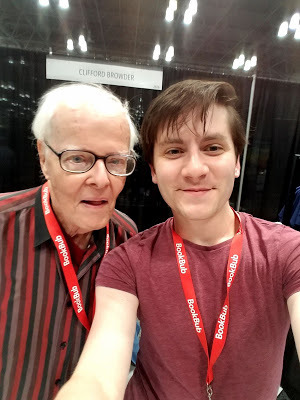 The odd couple. No need to say who's who.(Unless otherwise attributed, all the photos inthis and the next post are Silas's.)Make it fun
The odd couple. No need to say who's who.(Unless otherwise attributed, all the photos inthis and the next post are Silas's.)Make it funOf course, that goes without saying. But from my experience at the Rainbow Book Fair in 2012, and stories my artist friend Henry told of dealing with potential buyers, I know the woes of hawking your wares in person: someone shows an interest – even a keen interest – in what you're offering and then, having fueled your hopes of a sale, they walk blithely away. But BookCon is a festival, a fun time, so you have to squelch any feeling of annoyance or disappointment and hope for better. Sour looks and frowns are taboo. So flash your signs, offer them candy, smile, and have fun yourself; it will (hopefully) communicate.
Know the lingo
I picked it up online. You’ve got to feed the buzz. You want to be one of their faves, one of their besties. You want to geek out. lol
So much for advice. But how to get my stuff to the show?
Getting there
Exhibitors coming from a great distance contract with Freeman, the exclusive provider of freight services for the show, to ship their books and other stuff to a warehouse in Maspeth, New York, for later delivery, or they schedule the delivery so it arrives at just the right time at the Center. But one reason the show had tempted me from the start was that, living in the West Village, I was only a short ten-dollar taxi ride from the Javits. The move-in for BookExpo, with all the big publishers bringing hundreds of books and all kinds of stuff for their lavish displays, would be a frenzied horror, but the move-in for BookCon, the venue for small presses and indie authors like me who eschewed the delights of BookExpo, was very precise and limited: 5 p.m. to 9 p.m. on Friday, June 2, immediately following the close of BookExpo.
So it was that Silas and I stacked three cartons of books in my aging laundry cart, plus more books in our shoulder bags, and through the wonders of tech (his idea, of course) summoned a car by Lyft to my very doorstep in the Village, and took a quick ride up to the Javits at Eleventh Avenue and West 34th Street. When we got out and made for the entrance, we took a quick glance around us and saw towering high-rises under construction nearby, dwarfing by their height the massive glass box of the Javits. The Hudson Yards just to the south of the Javits were definitely “hot” real estate; the whole West Side was booming.
 The Jacob K. Javits Convention CenterEden, Janine and Jim
The Jacob K. Javits Convention CenterEden, Janine and JimInside, we found ourselves in a vast airplane hangar-like structure with huge stretches of space, big signs overhead announcing future events, and another giant sign, which we reached after a walk the equivalent of four city blocks, welcoming us to BookExpo and BookCon. We went at once to the registration counter and collected our red-ribboned exhibitor badges, without which we couldn’t get in, and hung them around our neck. But we had arrived a little before 5:00 p.m., when BookExpo ended and our move-in began, so we sat for a while nearby and met a couple visiting from China who wanted to see the U.N. building; the wife spoke English, so Silas gave her directions and we wished them well – a reminder of the international attraction of this city and the Javits.
At the magic hour of five we entered the huge exhibit floor and trudged this way and that until we saw a distant overhead sign that said 2800. Since our booth was #2876, we headed that way and found a vast lot of ... nothing. Right where we thought we should be located: nothing! At least, nothing that looked like our little section of BookCon. So Silas took off to find the office of Reed Exhibitions, who were running the show, to learn what the problem was; returning, he said there had been a little error, but the booths would soon be installed. Exploring further, he found a very empty booth numbered 2876, but no table or chairs, and most of the nearby booths likewise empty. I in turn scurried off to query Reed and was told: “No need to worry. The tables are on their way.” So we waited in the empty booth, screened in back by an eight-foot black curtain, and on either side by a low three-foot black curtain. Not that the place was deserted; beyond the end of our aisle there was a wide entrance to the loading docks, and fork-lifts came from there lumbering down our aisle like looming monsters, carrying huge cartons to other distant booths with displays far more elaborate than ours. Finally, about 6:00 p.m., workmen began arriving with the missing tables, and once ours was installed at the front of the booth, similarly draped in black, we felt that the booth, though still minus chairs, at least existed. Wanting to get a good night’s sleep, we decided to go home, hoping that the chairs would also arrive. Which they did, for we found them there when we arrived on Saturday morning.
 Me in the booth, with the Strand postcards and magnets close by.
Me in the booth, with the Strand postcards and magnets close by.Fellow toilers in the vineyard
Once we had installed our books, signs, and candy on the table, I took a quick look around at our neighbors. Just next to us was the Strand Bookstore booth, selling everything but books: postcards at a dollar apiece, magnets to be mounted on a refrigerator door or any metallic surface, T-shirts, totes, and even socks with brief messages like “ I love New York.” The postcards were mounted on stands right next to us, so we could feast our eyes on their messages:
FOR MOST OF HISTORY ANONYMOUS WAS A WOMANKEEP CALM AND CALL MOMMAKE AMERICA THINK AGAINGAY RIGHTS ARE HUMAN RIGHTSNEVERTHELESS SHE PERSISTEDA WELL-READ WOMAN IS A DANGEROUS CREATURE
I couldn’t resist buying one:
New York-ernoun – a fast-walking, fast-talking person who livesin the best city on earth.ex: “Get out of my way, I’m walking here.”
This is the abrasive image that New Yorkers themselves like to project, but I would argue that New Yorkers are in fact less aggressive, less rude, just direct and to the point.
And right next to the postcards were the magnets, with similar messages:
WE ARE EACH OF US A LITTLE UNIVERSEBORN TO READ / FORCED TO WORKYOUR GRAMMAR MAKES ME (SIC)I AM A CRAZY CAT LADY AND PROUD OF IT
How “with it” can you get? I predicted that the Strand products would fly off the shelves and the racks.
Just across the aisle from the Strand was Book Beau, advertising itself as “the best way to love your books.” And what did it offer? A water- and stain-resistant "sleeve" (thin bag) to protect books and make them look beautiful; there were many patterns, and they were indeed beautiful.
Next to Book Beau and just across from us was Kirin Rise Studios, with a big banner showing a young woman, maybe Asian, who was evidently the heroine of a novel by an author named Ed Cruz. Later I would learn that she lived in the year 2032 and used martial arts to fight bravely against government corruption and corporate greed – something we could use in 2017. But just what the booth was selling was never clear to me.
Next to Book Beau was what Silas and I came to refer to as the “mystery booth”: a booth at first empty, with a sign reading TRADE SECRET TRILOGY / 13 CUTS, which meant nothing to us. Later an African American family with a young child came to occupy the booth, but what they were up to baffled us. They were evidently presenting a series of books, but by whom and about what was not apparent. Later I learned that the author was “DOJ,” which hardly cleared things up. And a small card that we retrieved from their table had texts in such small print, and in such fancy type, that their enterprise remained shrouded in mystery. And this right across from the flagrantly and deliciously commercial offerings of the Strand!
At the magic hour of 10 a.m. on Saturday, June 3, the gates to BookCon 2017 swung wide open and hordes of female millennials, plus assorted others, began pouring onto the exhibit floor. We saw the first arrivals in the distance, some of them hurrying in our direction. Our adventure was at last beginning. “Two against twenty-five thousand,” I said to Silas. “How can we lose?”
Coming soon: Part 2 of BookCon, focused on attendees, plus notes on two of my BookCon neighbors, authors Jill Hynes and David Mammina. Who were the attendees, where were they from, what did they want, how did Silas and I interact with them, which books sold, and who were the buyers? Surprises galore; I would never have guessed.
© 2017 Clifford Browder
Published on June 11, 2017 05:20



